As filed with the Securities and Exchange Commission on March 10, 2011
UNITED STATES
SECURITIES AND EXCHANGE COMMISSION
Washington, D.C. 20549
FORM N-CSR
CERTIFIED SHAREHOLDER REPORT OF REGISTERED
MANAGEMENT INVESTMENT COMPANIES
Investment Company Act file Number: 811-21680
DCA Total Return Fund
(Exact Name of the Registrant as Specified in Charter)
518 17th Street, Suite 1200, Denver, CO 80202
(Address of Principal Executive Offices - Zip Code)
303-228-2200
Registrant’s Telephone Number, including area code
Jeffrey W. Taylor
President
518 17th Street, Suite 1200
Denver, CO 80202
(Names and Addresses of agents for service)
Date of fiscal year end: December 31
Date of reporting period: December 31, 2010
Item 1. Reports to Shareholders
The following is a copy of the report to shareholders pursuant to Rule 30e-1 under the Investment Company Act of 1940 (the “Act”).
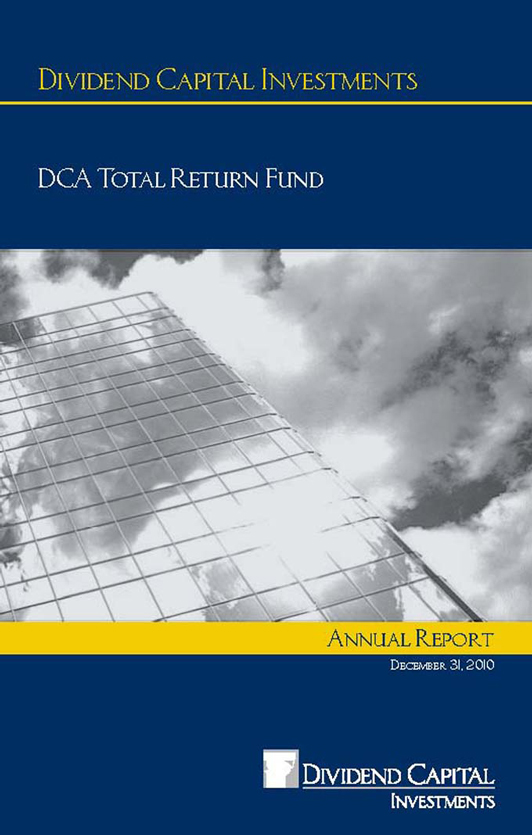
Dividend Capital Investments DCA Total Return Fund
Annual Report
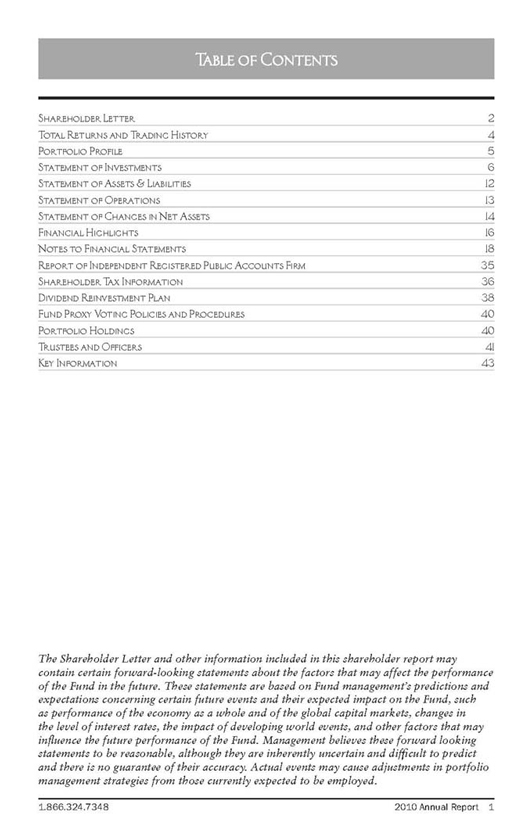
Table of Contents
Shareholder. Letter. 2
Total Returns and Trading History 4
Portfolio Profile 5
Statement of Investments 6
Statement of Assets & Liabilities 12
Statement of Operations 13
Statement of Changes in Net Assets 14
Financial Highlights 16
Notes to Financial Statements 18
Report of Independent Registered Public Accounts Firm 35
Shareholder Tax Information 36
Dividend Reinvestment Plan 38
Fund Proxy Voting Policies and Procedures 40
Portfolio Holdings 40
Trustees and Officers 41
Key Information 43
The Shareholder Letter and other information included in this shareholder report may contain certain forward-looking statements about the factors that may affect the performance of the Fund in the future. These statements are based on Fund management’s predictions and expectations concerning certain future events and their expected impact on the Fund, such as performance of the economy as a whole and of the global capital markets, changes in the level of interest rates, the impact of developing world events, and other factors that may influence the future performance of the Fund. Management believes these forward looking statements to be reasonable, although they are inherently uncertain and diffficult to predict and there is no guarantee of their accuracy. Actual events may cause adjustments in portfolio management strategies from those currently expected to be employed.
1.866.324.7348 2010 Annual Report 1
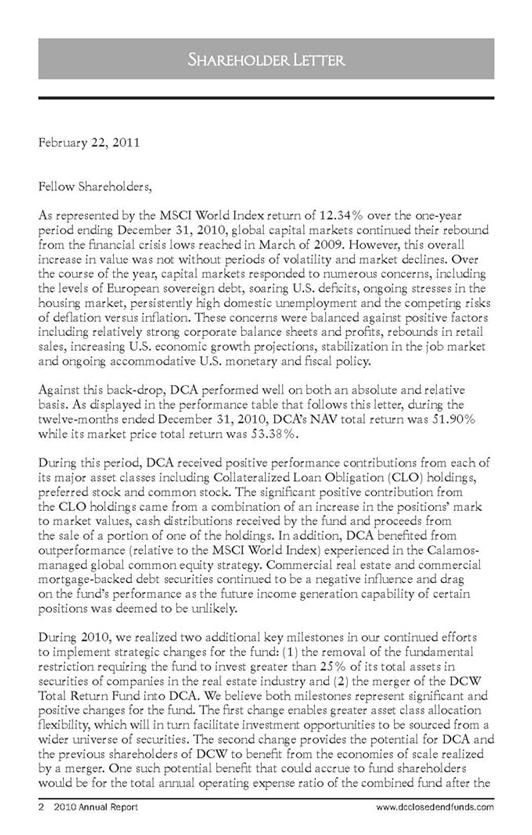
February 22, 2011
Fellow Shareholders,
As represented by the MSCI World Index return of 12.34% over the one-year period ending December 31, 2010, global capital markets continued their rebound from the financial crisis lows reached in March of 2009. However, this overall increase in value was not without periods of volatility and market declines. Over the course of the year, capital markets responded to numerous concerns, including the levels of European sovereign debt, soaring U.S. deficits, ongoing stresses in the housing market, persistently high domestic unemployment and the competing risks of deflation versus inflation. These concerns were balanced against positive factors including relatively strong corporate balance sheets and profits, rebounds in retail sales, increasing U.S. economic growth projections, stabilization in the job market and ongoing accommodative U.S. monetary and fiscal policy.
Against this back-drop, DCA performed well on both an absolute and relative basis. As displayed in the performance table that follows this letter, during the twelve-months ended December 31, 2010, DCA’s NAV total return was 51.90% while its market price total return was 53.38%.
During this period, DCA received positive performance contributions from each of its major asset classes including Collateralized Loan Obligation (CLO) holdings, preferred stock and common stock. The significant positive contribution from the CLO holdings came from a combination of an increase in the positions’ mark to market values, cash distributions received by the fund and proceeds from the sale of a portion of one of the holdings. In addition, DCA benefited from outperformance (relative to the MSCI World Index) experienced in the Calamos-managed global common equity strategy. Commercial real estate and commercial mortgage-backed debt securities continued to be a negative influence and drag on the fund’s performance as the future income generation capability of certain positions was deemed to be unlikely.
During 2010, we realized two additional key milestones in our continued efforts to implement strategic changes for the fund: (1) the removal of the fundamental restriction requiring the fund to invest greater than 25% of its total assets in securities of companies in the real estate industry and (2) the merger of the DCW Total Return Fund into DCA. We believe both milestones represent significant and positive changes for the fund. The first change enables greater asset class allocation flexibility, which will in turn facilitate investment opportunities to be sourced from a wider universe of securities. The second change provides the potential for DCA and the previous shareholders of DCW to benefit from the economies of scale realized by a merger. One such potential benefit that could accrue to fund shareholders would be for the total annual operating expense ratio of the combined fund after the
2 | | 2010 Annual Report www.dcclosedendfunds.com |
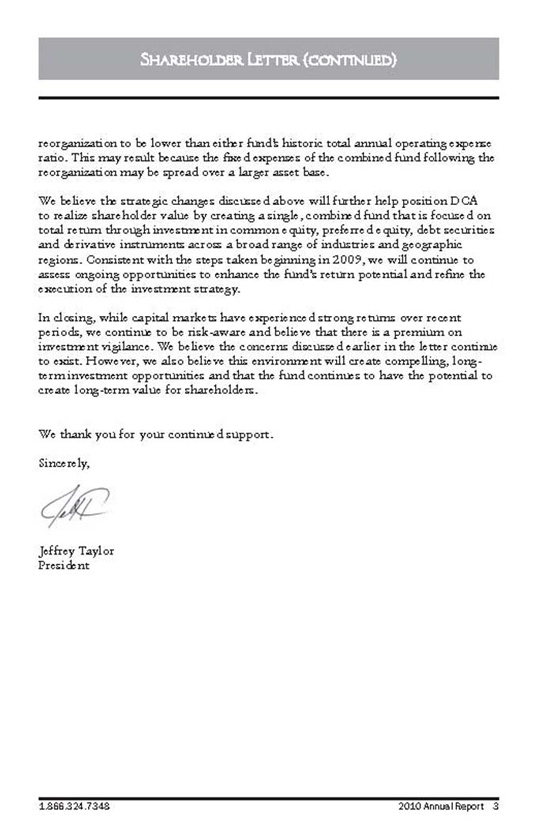
reorganization to be lower than either fund’s historic total annual operating expense ratio. This may result because the fixed expenses of the combined fund following the reorganization may be spread over a larger asset base.
We believe the strategic changes discussed above will further help position DCA to realize shareholder value by creating a single, combined fund that is focused on total return through investment in common equity, preferred equity, debt securities and derivative instruments across a broad range of industries and geographic regions. Consistent with the steps taken beginning in 2009, we will continue to assess ongoing opportunities to enhance the fund’s return potential and refine the execution of the investment strategy.
In closing, while capital markets have experienced strong returns over recent periods, we continue to be risk-aware and believe that there is a premium on investment vigilance. We believe the concerns discussed earlier in the letter continue to exist. However, we also believe this environment will create compelling, long-term investment opportunities and that the fund continues to have the potential to create long-term value for shareholders.
We thank you for your continued support. Sincerely,
Jeffrey Taylor President
1.866.324.7348 2010 Annual Report 3
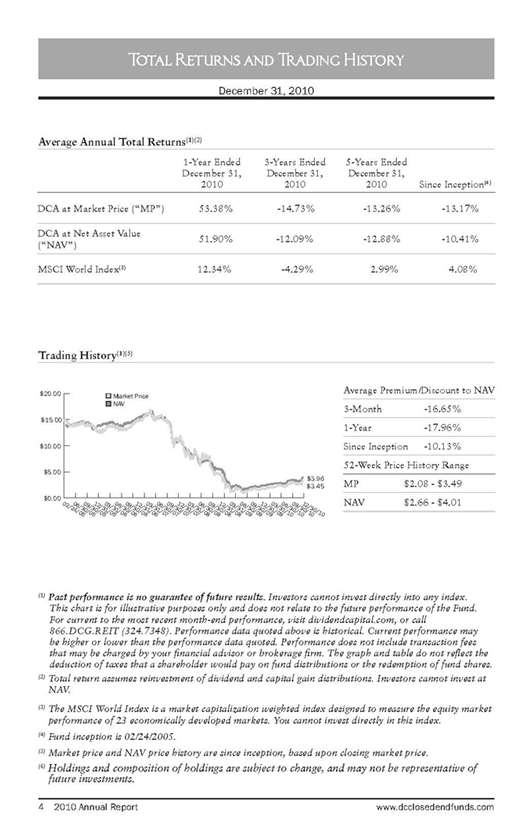
December 31, 2010
Average Annual Total Returns(1)(2)
1-Year Ended 3-Years Ended 5-Years Ended
December 31, December 31, December 31,
2010 2010 2010 Since Inception(
DCA at Market Price (“MP”) 53.38% -14.73% -13.26% -13.17%
DCAatNetAssetValue 51.90% -12.09% -12.88% -10.41% ( “NAV” )
MSCI World Index(3) 12.34% -4.29% 2.99% 4.08%
Trading History(1)(5)
Average Premium/Discount to NAV 3-Month -16.65%
1-Year -17.96%
Since Inception -10.13% 52-Week Price History Range MP $2.08—$3.49
NAV $2.66—$4.01
1) Past performance is no guarantee of future results. Investors cannot invest directly into any index. This chart is for illustrative purposes only and does not relate to the future performance of the Fund. For current to the most recent month-end performance, visit dividendcapital.com, or call 866.DCG.REIT (324.7348). Performance data quoted above is historical. Current performance may be higher or lower than the performance data quoted. Performance does not include transaction fees that may be charged by your financial advisor or brokerage firm. The graph and table do not reflect the deduction of taxes that a shareholder would pay on fund distributions or the redemption of fund shares.
(2) | | Total return assumes reinvestment of dividend and capital gain distributions. Investors cannot invest at NAV. |
(3) The MSCI World Index is a market capitalization weighted index designed to measure the equity market performance of 23 economically developed markets. You cannot invest directly in this index.
(4) | | Fund inception is 02/24/2005. |
(5) | | Market price and NAV price history are since inception, based upon closing market price. |
(6) | | Holdings and composition of holdings are subject to change, and may not be representative of future investments. |
4 | | 2010 Annual Report www.dcclosedendfunds.com |
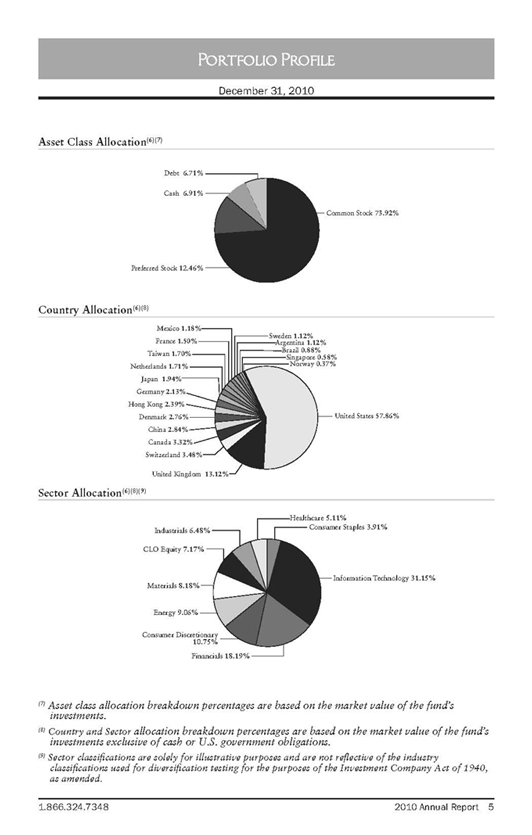
December 31, 2010 Asset Class Allocation(6)(7)
Debt 6.71%—,
Cash 6.91%
Common Stock 73.92%
Preferred Stock 12.46 %
Country Allocation(6)(8)
Denmark 2.76%B|lE~==a United States 57.86%
United Kingdom 13.12%
Sector Allocation(6)(8)(9
Healthcare 5.11%
Information Technology 31.15%
Consumer Discretionary sf
(7) | | Asset class allocation breakdown percentages are based on the market value of the fund’s investments. |
(8) Country and Sector allocation breakdown percentages are based on the market value of the fund’s investments exclusive of cash or U.S. government obligations.
(9) | | Sector classifications are solely for illustrative purposes and are not reflective of the industry |
classifications used for diversification testing for the purposes of the Investment Company Act of 1940, as amended.
1.866.324.7348 2010 Annual Report 5

December 31, 2010
Market
Shares Value COMMON STOCK 75.91%
Consumer Discretionary 10.28%
Amazon.com Inc.* 20,350 $3,663,000
NetFlix Inc.* 2,100 368,970
NIKE Inc. — Class B 8,000 683,360
priceline.com Inc.* 8,880 3,548,004
Puma AG Rudolf Dassler Sport 1,900 627,130
Swatch Group AG 28,500 2,298,289
11,188,753
Consumer Staples 3.73%
Cia De Bebidas Das Americas 30,000 913,012
Coca-Cola Co. 11,500 756,355
Henkel AG & Co. KGaA 12,100 756,401
Herbalife Ltd. 6,000 410,220
Wal-Mart de Mexico SAB de CV 430,000 1,228,721
4,064,709
Energy 8.66%
Acergy SA 28,000 686,198
AMEC PLC 82,500 1,479,186
Apache Corp. 12,500 1,490,375
CNOOC Ltd. 626,993 1,487,463
Core Laboratories NV 3,600 320,580
Helmerich & Payne Inc. 15,000 727,200
Occidental Petroleum Corp. 6,958 682,580
Petrofac Ltd. 16,000 395,884
Schlumberger Ltd. 6,000 501,000
Subsea7Inc.* 14,600 380,072
Technip SA 13,000 1,200,406
Whiting Petroleum Corp.* 677 79,338
9,430,282
Financials 4.56%
Franklin Resources Inc. 7,400 822,954
Schroders PLC 56,500 1,634,042
Singapore Exchange Ltd. 92,000 603,608
Standard Chartered PLC 44,000 1,183,692
T. Rowe Price Group Inc. 11,100 716,394
4,960,690
HealthCare 4.88%
Alexion Pharmaceuticals Inc.* 2,600 209,430
Bruker Biosciences Corp.* 26,500 439,900
Elekta AB — Class B 30,300 1,165,931
IlluminaInc.* 9,900 627,066
Novo Nordisk A/S — Class B 25,500 2,875,467
5,317,794
Footnotes to DCA Statement of Investments on pages 10-11.
6 | | 2010 Annual Report www.dcclosedendfunds.com |
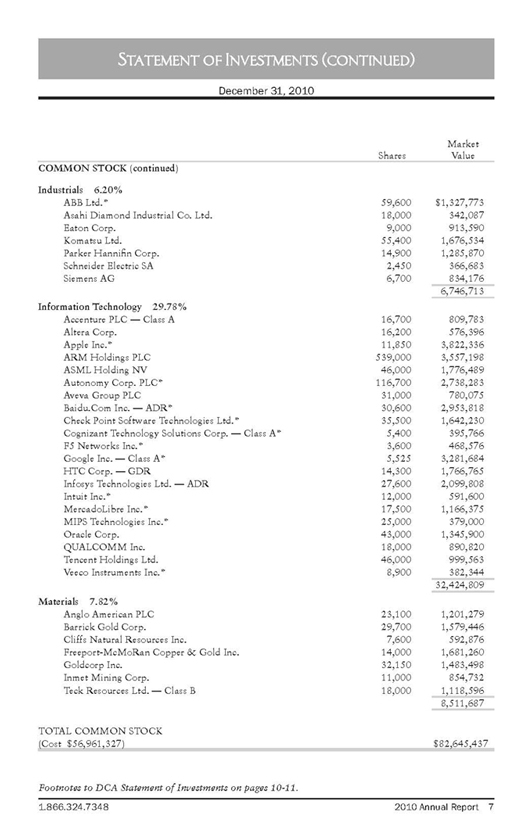
Statement of Investments (continued)
Market
Shares Value COMMON STOCK (continued)
Industrials 6.20%
ABB Ltd.* 59,600 $1,327,773
Asahi Diamond Industrial Co. Ltd. 18,000 342,087
Eaton Corp. 9,000 913,590
Komatsu Ltd. 55,400 1,676,534
Parker Hannifin Corp. 14,900 1,285,870
Schneider Electric SA 2,450 366,683
Siemens AG 6,700 834,176
6,746,713
Information Technology 29.78%
Accenture PLC — Class A 16,700 809,783
Altera Corp. 16,200 576,396
Apple Inc.* 11,850 3,822,336
ARM Holdings PLC 539,000 3,557,198
ASML Holding NV 46,000 1,776,489
Autonomy Corp. PLC* 116,700 2,738,283
Aveva Group PLC 31,000 780,075
Baidu.Com Inc. — ADR* 30,600 2,953,818
Check Point Software Technologies Ltd.* 35,500 1,642,230
Cognizant Technology Solutions Corp. — Class A* 5,400 395,766
F5 Networks Inc.* 3,600 468,576
Google Inc. — Class A* 5,525 3,281,684
HTC Corp. — GDR 14,300 1,766,765
Infosys Technologies Ltd. — ADR 27,600 2,099,808
Intuit Inc.* 12,000 591,600
MercadoLibre Inc.* 17,500 1,166,375
MIPS Technologies Inc.* 25,000 379,000
Oracle Corp. 43,000 1,345,900
QUALCOMM Inc. 18,000 890,820
Tencent Holdings Ltd. 46,000 999,563
Veeco Instruments Inc.* 8,900 382,344
32,424,809
Materials 7.82%
Anglo American PLC 23,100 1,201,279
Barrick Gold Corp. 29,700 1,579,446
Cliffs Natural Resources Inc. 7,600 592,876
Freeport-McMoRan Copper & Gold Inc. 14,000 1,681,260
Goldcorp Inc. 32,150 1,483,498
Inmet Mining Corp. 11,000 854,732
Teck Resources Ltd. — Class B 18,000 1,118,596
8,511,687
TOTAL COMMON STOCK
(Cost $56,961,327) $82,645,437
Footnotes to DCA Statement of Investments on pages 10-11.
1.866.324.7348 2010 Annual Report 7
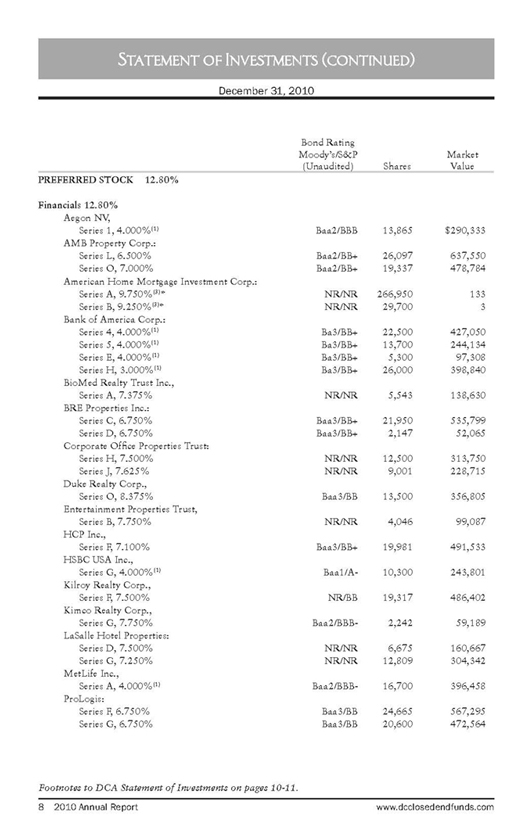
December 31, 2010
Bond Rating
Moody’s/S&P Market
(Unaudited) Shares Value
PREFERRED STOCK 12.80%
Financials 12.80%
Aegon NV,
Series 1, 4.000%(1) Baa2/BBB 13,865 $290,333
AMB Property Corp.:
Series L, 6.500% Baa2/BB+ 26,097 637,550
Series O, 7.000% Baa2/BB+ 19,337 478,784
American Home Mortgage Investment Corp.:
Series A, 9.750%(3)* NR/NR 266,950 133
Series B, 9.250%(3)* NR/NR 29,700 3
Bank of America Corp.:
Series 4, 4.000%(1) Ba3/BB+ 22,500 427,050
Series 5, 4.000%(1) Ba3/BB+ 13,700 244,134
Series E, 4.000%(1) Ba3/BB+ 5,300 97,308
Series H, 3.000%(1) Ba3/BB+ 26,000 398,840
BioMed Realty Trust Inc.,
Series A, 7.375% NR/NR 5,543 138,630
BRE Properties Inc.:
Series C, 6.750% Baa3/BB+ 21,950 535,799
Series D, 6.750% Baa3/BB+ 2,147 52,065
Corporate Offfice Properties Trust:
Series H, 7.500% NR/NR 12,500 313,750
Series J, 7.625% NR/NR 9,001 228,715
Duke Realty Corp.,
Series O, 8.375% Baa3/BB 13,500 356,805
Entertainment Properties Trust,
Series B, 7.750% NR/NR 4,046 99,087
HCP Inc.,
Series F, 7.100% Baa3/BB+ 19,981 491,533
HSBC USA Inc.,
Series G, 4.000%(1) Baa1/A- 10,300 243,801
Kilroy Realty Corp.,
Series F, 7.500% NR/BB 19,317 486,402
Kimco Realty Corp.,
Series G, 7.750% Baa2/BBB- 2,242 59,189
LaSalle Hotel Properties:
Series D, 7.500% NR/NR 6,675 160,667
Series G, 7.250% NR/NR 12,809 304,342
MetLife Inc.,
Series A, 4.000%(1) Baa2/BBB- 16,700 396,458
ProLogis:
Series F, 6.750% Baa3/BB 24,665 567,295
Series G, 6.750% Baa3/BB 20,600 472,564
Footnotes to DCA Statement of Investments on pages 10-11.
8 | | 2010 Annual Report www.dcclosedendfunds.com |
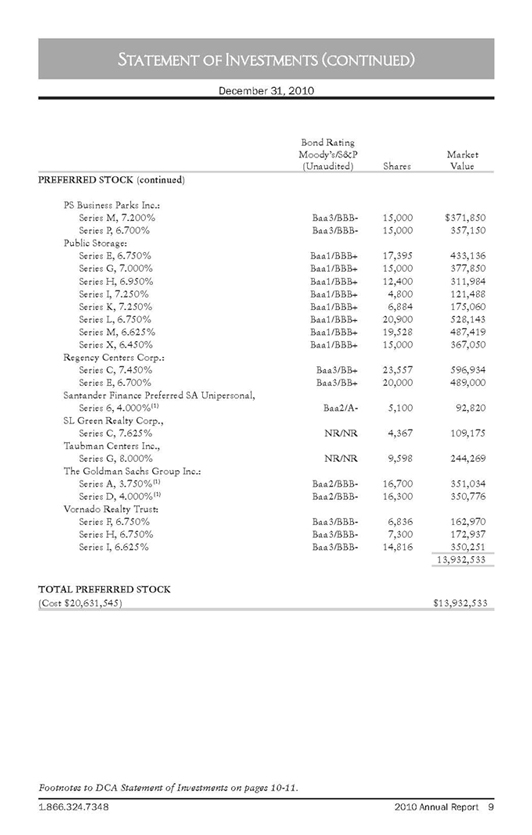
December 31, 2010
Bond Rating
Moody’s/S&P Market
(Unaudited) Shares Value
PREFERRED STOCK (continued)
PS Business Parks Inc.:
Series M, 7.200% Baa3/BBB- 15,000 $371,850
Series P, 6.700% Baa3/BBB- 15,000 357,150
Public Storage:
Series E, 6.750% Baa1/BBB+ 17,395 433,136
Series G, 7.000% Baa1/BBB+ 15,000 377,850
Series H, 6.950% Baa1/BBB+ 12,400 311,984
Series I,7.250% Baa1/BBB+ 4,800 121,488
Series K, 7.250% Baa1/BBB+ 6,884 175,060
Series L, 6.750% Baa1/BBB+ 20,900 528,143
Series M, 6.625% Baa1/BBB+ 19,528 487,419
Series X, 6.450% Baa1/BBB+ 15,000 367,050
Regency Centers Corp.:
Series C, 7.450% Baa3/BB+ 23,557 596,934
Series E, 6.700% Baa3/BB+ 20,000 489,000
Santander Finance Preferred SA Unipersonal,
Series 6, 4.000%(1) Baa2/A- 5,100 92,820
SL Green Realty Corp.,
Series C, 7.625% NR/NR 4,367 109,175
Taubman Centers Inc.,
Series G, 8.000% NR/NR 9,598 244,269
The Goldman Sachs Group Inc.:
Series A, 3.750%(1) Baa2/BBB- 16,700 351,034
Series D, 4.000%(1) Baa2/BBB- 16,300 350,776
Vornado Realty Trust:
Series F, 6.750% Baa3/BBB- 6,836 162,970
Series H, 6.750% Baa3/BBB- 7,300 172,937
Series I, 6.625% Baa3/BBB- 14,816 350,251
13,932,533
TOTAL PREFERRED STOCK
(Cost $20,631,545) $13,932,533
Footnotes to DCA Statement of Investments on pages 10-11.
1.866.324.7348 2010 Annual Report 9
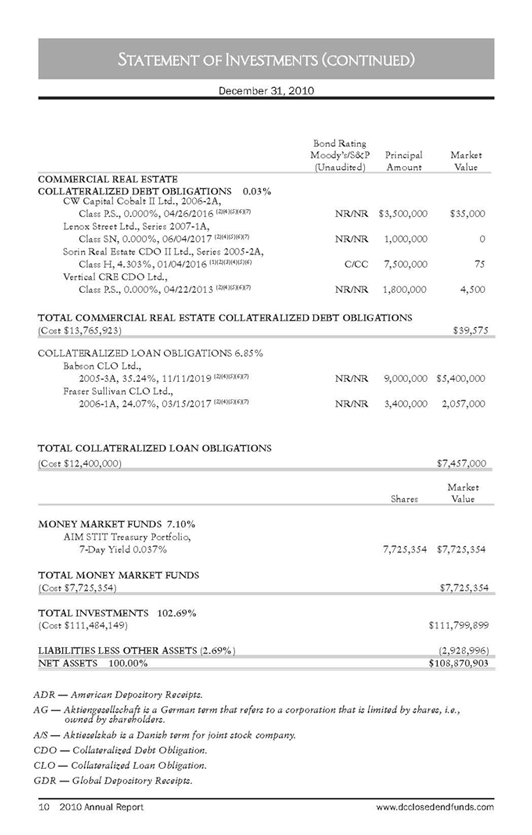
December 31, 2010
Bond Rating
Moody’s/S&P Principal Market
()Unaudited) Amount Value
COMMERCIAL REAL ESTATE COLLATERALIZED DEBT OBLIGATIONS 0.03% CW Capital Cobalt II Ltd., 2006-2A,
Class P.S., 0.000%, 04/26/2016 (2)(4)(5)(6)(7) NR/NR $3,500,000 $35,000
Lenox Street Ltd., Series 2007-1A,
Class SN, 0.000%, 06/04/2017 (2)(4)(5)(6)(7) NR/NR 1,000,000 0
Sorin Real Estate CDO II Ltd., Series 2005-2A,
Class H, 4.303%, 01/04/2016 (1)(2)(3)(4)(5)(6) C/CC 7,500,000 75
Vertical CRE CDO Ltd.,
Class P.S., 0.000%, 04/22/2013 (2)(4)(5)(6)(7) NR/NR 1,800,000 4,500
TOTAL COMMERCIAL REAL ESTATE COLLATERALIZED DEBT OBLIGATIONS
(,,)Cost $13,765,923) $39,575
COLLATERALIZED LOAN OBLIGATIONS 6.85% Babson CLO Ltd.,
2005-3A, 35.24%, 11/11/2019 (2)(4)(5)(6)(7) NR/NR 9,000,000 $5,400,000
Fraser Sullivan CLO Ltd.,
2006-1A, 24.07%, 03/15/2017 (2)(4)(5)(6)(7) NR/NR 3,400,000 2,057,000
TOTAL COLLATERALIZED LOAN OBLIGATIONS
(Cost $12,400,000) $7,457,000
Market Shares Value
MONEY MARKET FUNDS 7.10% AIM STIT Treasury Portfolio,
7-Day Yield 0.037% 7,725,354 $7,725,354
TOTAL MONEY MARKET FUNDS
(,,)Cost $7,725,354) $7,,725,354
TOTAL INVESTMENTS 102.69%
(Cost $111,484,149) $111,799,899
LIABILITIES LESS OTHER ASSETS ()2.69%) (,,)2,928,996)
NET ASSETS 100.00% $108,870,903
ADR — American Depository Receipts.
AG — Aktiengesellschaft is a German term that refers to a corporation that is limited by shares, i.e., owned by shareholders.
A/S — Aktieselskab is a Danish term for joint stock company. CDO — Collateralized Debt Obligation. CLO — Collateralized Loan Obligation. GDR — Global Depository Receipts.
10 2010 Annual Report www.dcclosedendfunds.com
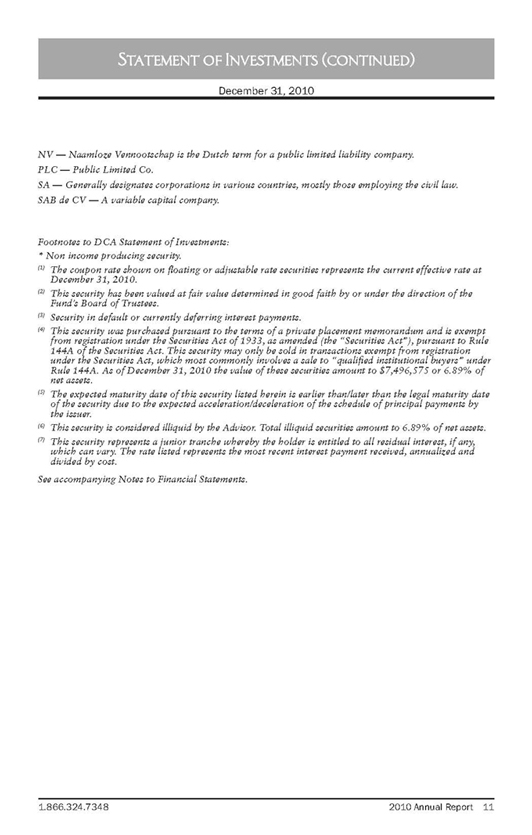
December 31, 2010
NV— Naamloze Vennootschap is the Dutch term for a public limited liability company.
PLC — Public Limited Co.
SA — Generally designates corporations in various countries, mostly those employing the civil law.
SAB de CV — A variable capital company.
Footnotes to DCA Statement of Investments: * Non income producing security.
1) The coupon rate shown on floating or adjustable rate securities represents the current effective rate at December 31, 2010.
(2) This security has been valued at fair value determined in good faith by or under the direction of the Fund’s Board of Trustees.
(3) | | Security in default or currently deferring interest payments. |
(4) This security was purchased pursuant to the terms of a private placement memorandum and is exempt from registration under the Securities Act of 1933, as amended (the “Securities Act”), pursuant to Rule 144A of the Securities Act. This security may only be sold in transactions exempt from registration under the Securities Act, which most commonly involves a sale to “qualified institutional buyers” under Rule 144A. As of December 31, 2010 the value of these securities amount to $7,496,575 or 6.89% of net assets.
(5) The expected maturity date of this security listed herein is earlier than/later than the legal maturity date of the security due to the expected acceleration/deceleration of the schedule of principal payments by the issuer.
(6) | | This security is considered illiquid by the Advisor. Total illiquid securities amount to 6.89% of net assets. |
(7) This security represents a junior tranche whereby the holder is entitled to all residual interest, if any, which can vary. The rate listed represents the most recent interest payment received, annualized and divided by cost.
See accompanying Notes to Financial Statements.
1.866.324.7348 2010 Annual Report 11
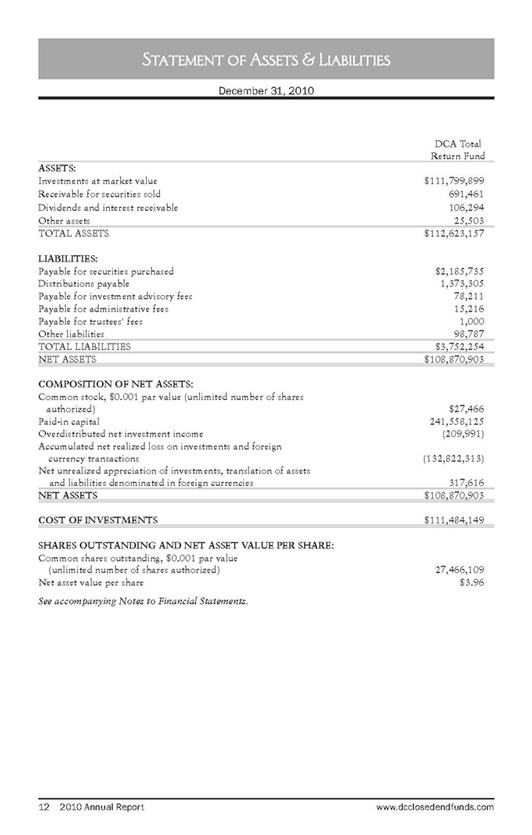
December 31, 2010
DCA Total Return Fund ASSETS:
Investments at market value $111,799,899
Receivable for securities sold 691,461
Dividends and interest receivable 106,294
Other assets 25,503
TOTAL ASSETS $112,623,157
LIABILITIES:
Payable for securities purchased $2,185,735
Distributions payable 1,373,305
Payable for investment advisory fees 78,211
Payable for administrative fees 15,216
Payable for trustees’ fees 1,000
Other liabilities 98,,787
TOTAL LIABILITIES $3,752,254
NET ASSETS $108,,870,903
COMPOSITION OF NET ASSETS:
Common stock, $0.001 par value (unlimited number of shares
authorized) $27,466
Paid-in capital 241,558,125
Overdistributed net investment income (209,991) Accumulated net realized loss on investments and foreign
currency transactions (132,822,313) Net unrealized appreciation of investments, translation of assets
and liabilities denominated in foreign currencies 317,616
NET ASSETS $108,,870,903
COST OF INVESTMENTS $111,,484,149
SHARES OUTSTANDING AND NET ASSET VALUE PER SHARE: Common shares outstanding, $0.001 par value
(unlimited number of shares authorized) 27,466,109
Net asset value per share $3.96
See accompanying Notes to Financial Statements.
12 2010 Annual Report www.dcclosedendfunds.com
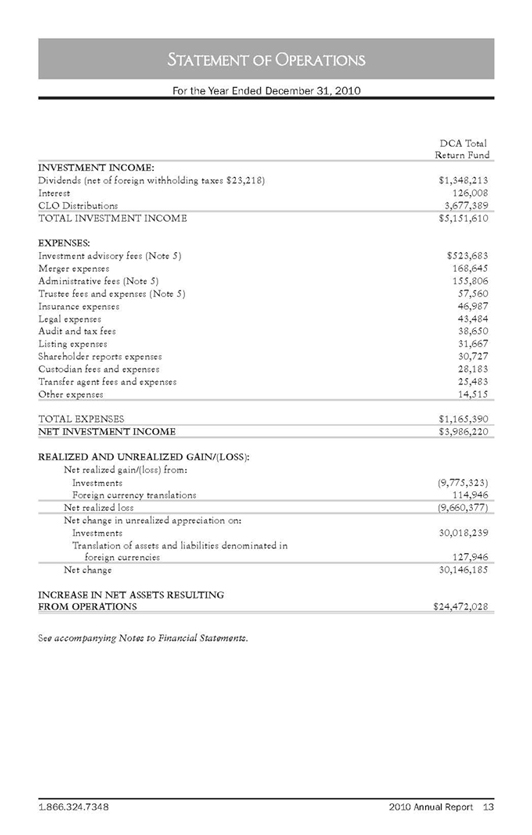
For the Year Ended December 31, 2010
DCA Total Return Fund INVESTMENT INCOME:
Dividends (net of foreign withholding taxes $23,218) $1,348,213
Interest 126,008
CLO Distributions 3,6,,77,389
TOTAL INVESTMENT INCOME $5,151,610
EXPENSES:
Investment advisory fees (Note 5) $523,683
Merger expenses 168,645
Administrative fees (Note 5) 155,806
Trustee fees and expenses (Note 5) 57,560
Insurance expenses 46,987
Legal expenses 43,484
Audit and tax fees 38,650
Listing expenses 31,667
Shareholder reports expenses 30,727
Custodian fees and expenses 28,183
Transfer agent fees and expenses 25,483
Other expenses 14,515
TOTAL EXPENSES $1,165,390
NET INVESTMENT INCOME $3,986,220
REALIZED AND UNREALIZED GAIN/(LOSS): Net realized gain/(loss) from:
Investments (9,775,323)
Foreign currency translations 114,946
Net realized loss (9,660,377) Net change in unrealized appreciation on:
Investments 30,018,239
Translation of assets and liabilities denominated in
foreign currencies 127,946
Net change 30,146,185
INCREASE IN NET ASSETS RESULTING
FROM OPERATIONS $24,,472,028
See accompanying Notes to Financial Statements.
1.866.324.7348 2010 Annual Report 13
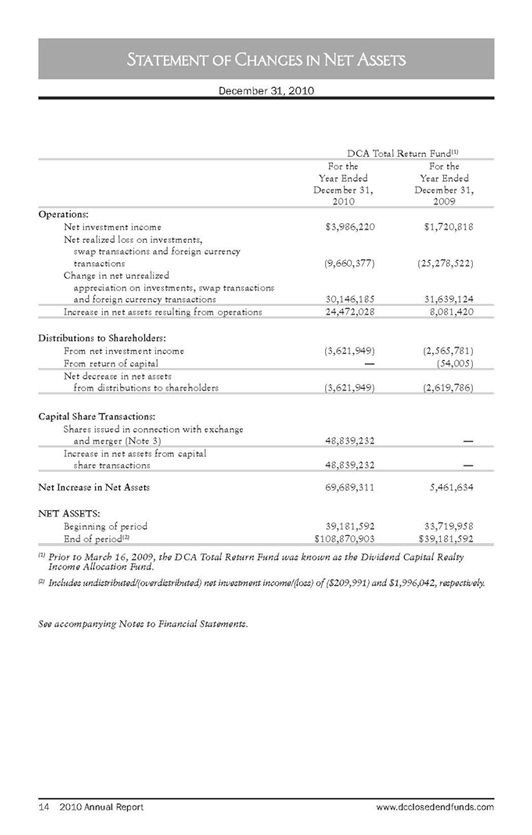
December 31, 2010
DCA Total Return Fund( 1 For the For the
Year Ended Year Ended
December 31, December 31,
2010 2009
Operations:
Net investment income $3,986,220 $1,720,818
Net realized loss on investments,
swap transactions and foreign currency
transactions (9,660,377) (25,278,522)
Change in net unrealized appreciation on investments, swap transactions
and foreign currency transactions 30,146,185 31,639,124
Increase in net assets resulting from operations 24,472,028 8,081,420
Distributions to Shareholders:
From net investment income (3,621,949) (2,565,781)
From return of capital — (,)54,005)
Net decrease in net assets
from distributions to shareholders (3,621,949) (2,619,786)
Capital Share Transactions:
Shares issued in connection with exchange
and merger (Note 3) 48,839,232g(),, —
Increase in net assets from capital
share transactions 48,839,232,, —
Net Increase in Net Assets 69,689,311 5,461,634
NET ASSETS:
Beginning of period 39,181,592 33,719,958
End of period(2) $108,870,903 $39,181,592
(1) | | Prior to March 16, 2009, the DCA Total Return Fund was known as the Dividend Capital Realty Income Allocation Fund. |
(2) Includes undistributed/(overdistributed) net investment income/(loss) of ($209,991) and $1,996,042, respectively. See accompanying Notes to Financial Statements.
14 2010 Annual Report www.dcclosedendfunds.com
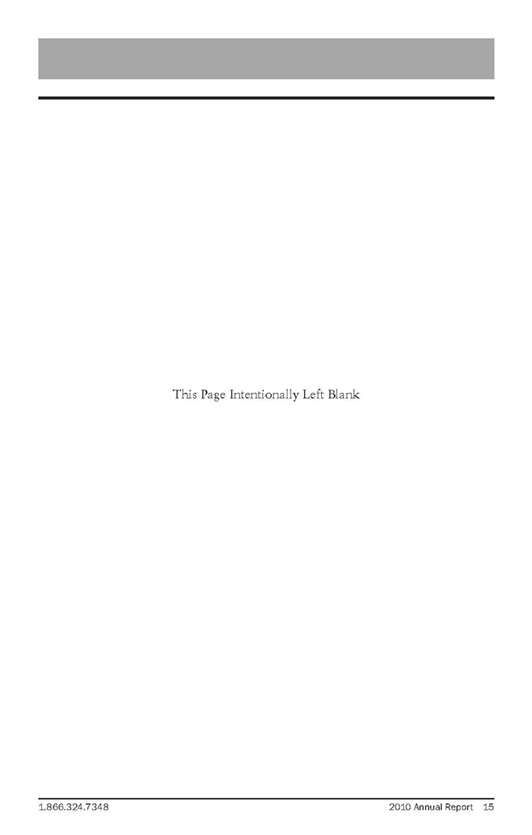
This Page Intentionally Left Blank
1.866.324.7348 2010 Annual Report 15
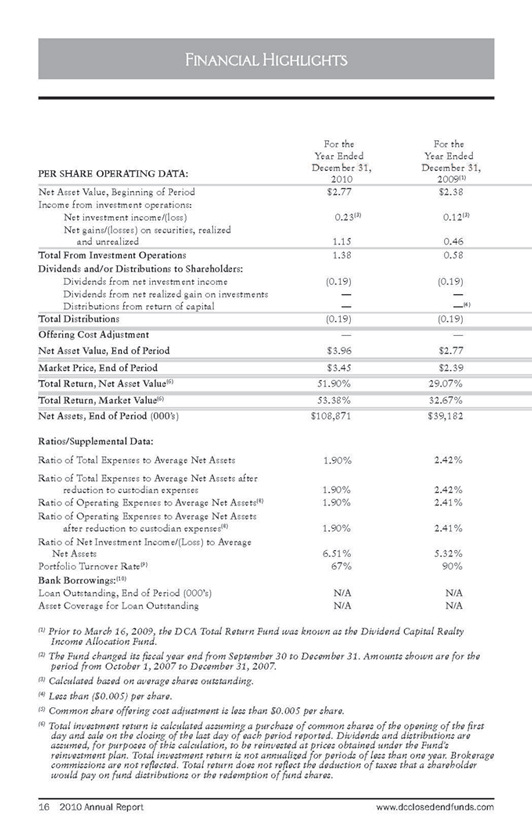
For the For the
Year Ended Year Ended
PER SHARE OPERATING DATA: December 31, December 31,
Net Asset Value, Beginning of Period $2.77 $2.38 Income from investment operations:
Net investment income/(loss) 0.23(3) 0.12(3) Net gains/(losses) on securities, realized
and unrealized 1.15 0.46
Total From Investment Operations 1.38 0.58 Dividends and/or Distributions to Shareholders:
Dividends from net investment income (0.19) (0.19)
Dividends from net realized gain on investments — —
Distributions from return of capital — —(
Total Distributions (0.19) (0.19)
Offering Cost Adjustment — —
Net Asset Value, End of Period $3.96 $2.77
Market Price, End of Period $3.45 $2.39
Total Return, Net Asset Value(6) 51.90% 29.07%
Total Return, Market Value(6) 53.38% 32.67%
Net Assets, End of Period (000’s) $108,871 $39,182
Ratios/Supplemental Data:
Ratio of Total Expenses to Average Net Assets 1.90% 2.42%
Ratio of Total Expenses to Average Net Assets after
reduction to custodian expenses 1.90% 2.42%
Ratio of Operating Expenses to Average Net Assets(8) 1.90% 2.41% Ratio of Operating Expenses to Average Net Assets
after reduction to custodian expenses(8) 1.90% 2.41% Ratio of Net Investment Income/(Loss) to Average
Net Assets 6.51% 5.32%
Portfolio Turnover Rate(9) 67% 90% Bank Borrowings:(10)
Loan Outstanding, End of Period (000’s) N/A N/A
Asset Coverage for Loan Outstanding N/A N/A
(1) | | Prior to March 16, 2009, the DCA Total Return Fund was known as the Dividend Capital Realty Income Allocation Fund. |
(2) The Fund changed its fiscal year end from September 30 to December 31. Amounts shown are for the period from October 1, 2007 to December 31, 2007.
(3) | | Calculated based on average shares outstanding. |
(4) | | Less than ($0.005) per share. |
(5) | | Common share offering cost adjustment is less than $0.005 per share. |
(6) Total investment return is calculated assuming a purchase of common shares of the opening of the first day and sale on the closing of the last day of each period reported. Dividends and distributions are assumed, for purposes of this calculation, to be reinvested at prices obtained under the Fund’s reinvestment plan. Total investment return is not annualized for periods of less than one year. Brokerage commissions are not reflected. Total return does not reflect the deduction of taxes that a shareholder would pay on fund distributions or the redemption of fund shares.
16 2010 Annual Report www.dcclosedendfunds.com
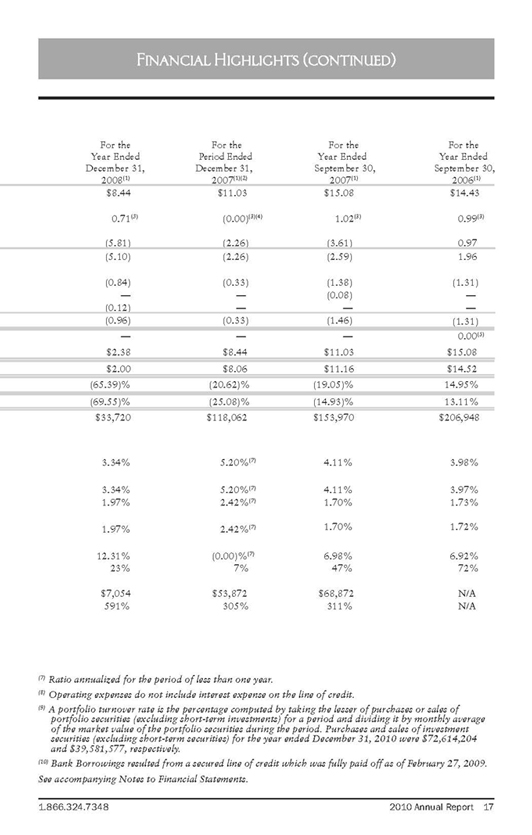
For the For the For the For the
Year Ended Period Ended Year Ended Year Ended
December 31, December 31, September 30, September 30,
2008’” 2007(1)(2) 2007” 2006’”
$8.44 $11.03 $15.08 $14.43
0.71(3) (0.00)(3)(4) 1.02(3) 0.99(3)
(5.81) (2.26) (3.61) 0.97
(5.10) (2.26) (2.59) 1.96
(0.84) (0.33) (1.38) (1.31)
— (0.08) — (0.12) — — — (0.96) (0.33) (1.46) (1.31)
— — 0.00(5) $2.38 $8.44 $11.03 $15.08 $2.00 $8.06 $11.16 $14.52
(65.39)% (20.62)% (19.05)% 14.95%
(69.55)% (25.08)% ~ (14.93)% ~ 13.11%
$33,720 $118,062 $153,970 $206,948
3.34% 5.20%(7) 4.11% 3.98%
3.34% 5.20%(7) 4.11% 3.97%
1.97% 2.42%(7) 1.70% 1.73%
1.97% 2.42%(7) 1.70% 1.72%
12.31% (0.00)%(7) 6.98% 6.92%
23% 7% 47% 72%
$7,054 $53,872 $68,872 N/A
591% 305% 311% N/A
(7) | | Ratio annualized for the period of less than one year. |
(8) | | Operating expenses do not include interest expense on the line of credit. |
(9) A portfolio turnover rate is the percentage computed by taking the lesser of purchases or sales of portfolio securities (excluding short-term investments) for a period and dividing it by monthly average of the market value of the portfolio securities during the period. Purchases and sales of investment securities (excluding short-term securities) for the year ended December 31, 2010 were $72,614,204 and $39,581,577, respectively.
(10) Bank Borrowings resulted from a secured line of credit which was fully paid off as of February 27, 2009. See accompanying Notes to Financial Statements.
1.866.324.7348 2010 Annual Report 17
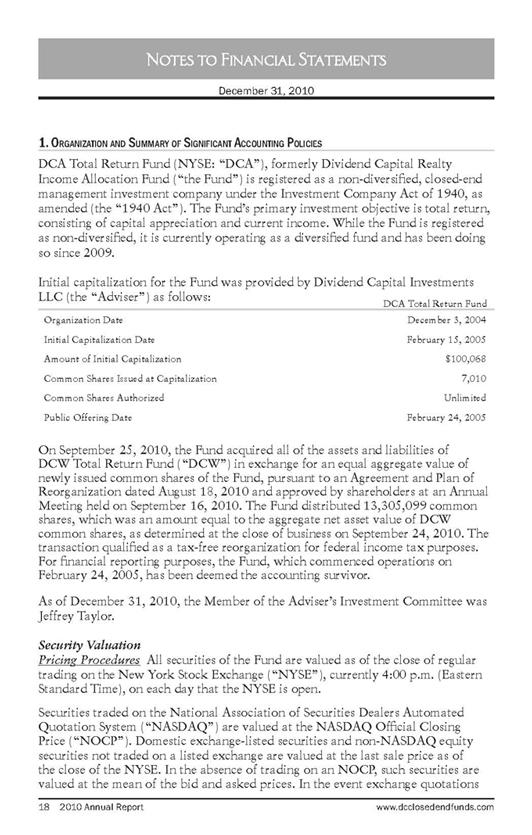
December 31, 2010
1. Organization and Summary ofF Significant Accounting PoLIcies
DCA Total Return Fund (NYSE: “DCA”), formerly Dividend Capital Realty Income Allocation Fund (“the Fund”) is registered as a non-diversified, closed-end management investment company under the Investment Company Act of 1940, as amended (the “1940 Act”). The Fund’s primary investment objective is total return, consisting of capital appreciation and current income. While the Fund is registered as non-diversified, it is currently operating as a diversified fund and has been doing so since 2009.
Initial capitalization for the Fund was provided by Dividend Capital Investments LLC (the “Adviser”) as follows:
DCA Total Return Fund
Organization Date December 3, 2004
Initial Capitalization Date February 15, 2005
Amount of Initial Capitalization $100,068
Common Shares Issued at Capitalization 7,010
Common Shares Authorized Unlimited
Public Offering Date February 24, 2005
On September 25, 2010, the Fund acquired all of the assets and liabilities of DCW Total Return Fund (“DCW”) in exchange for an equal aggregate value of newly issued common shares of the Fund, pursuant to an Agreement and Plan of Reorganization dated August 18, 2010 and approved by shareholders at an Annual Meeting held on September 16, 2010. The Fund distributed 13,305,099 common shares, which was an amount equal to the aggregate net asset value of DCW common shares, as determined at the close of business on September 24, 2010. The transaction qualified as a tax-free reorganization for federal income tax purposes. For financial reporting purposes, the Fund, which commenced operations on February 24, 2005, has been deemed the accounting survivor.
As of December 31, 2010, the Member of the Adviser’s Investment Committee was Jeffrey Taylor.
Security Valuation
Pricing Procedures All securities of the Fund are valued as of the close of regular trading on the New York Stock Exchange (“NYSE”), currently 4:00 p.m. (Eastern Standard Time), on each day that the NYSE is open.
Securities traded on the National Association of Securities Dealers Automated Quotation System (“NASDAQ”) are valued at the NASDAQ Offficial Closing Price (“NOCP”). Domestic exchange-listed securities and non-NASDAQ equity securities not traded on a listed exchange are valued at the last sale price as of the close of the NYSE. In the absence of trading on an NOCP, such securities are valued at the mean of the bid and asked prices. In the event exchange quotations
18 2010 Annual Report www.dcclosedendfunds.com
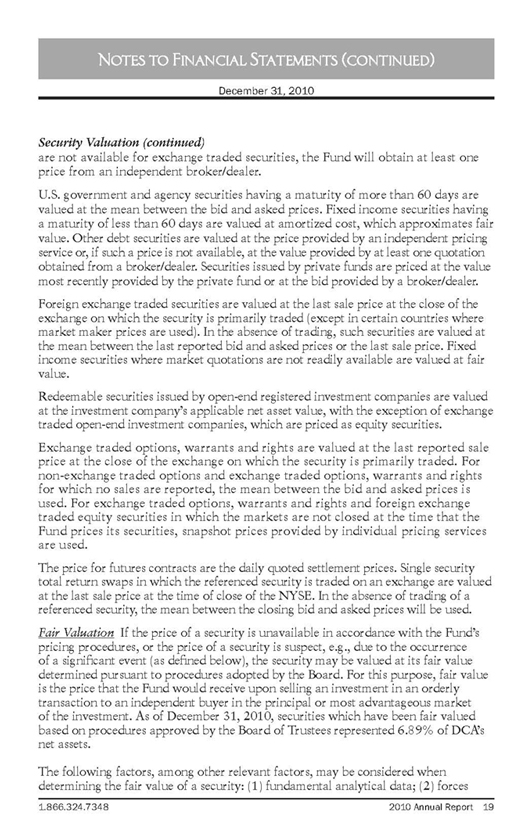
December 31, 2010
Security Valuation (continued)
are not available for exchange traded securities, the Fund will obtain at least one
price from an independent broker/dealer.
U.S. government and agency securities having a maturity of more than 60 days are valued at the mean between the bid and asked prices. Fixed income securities having a maturity of less than 60 days are valued at amortized cost, which approximates fair value. Other debt securities are valued at the price provided by an independent pricing service or, if such a price is not available, at the value provided by at least one quotation obtained from a broker/dealer. Securities issued by private funds are priced at the value most recently provided by the private fund or at the bid provided by a broker/dealer.
Foreign exchange traded securities are valued at the last sale price at the close of the exchange on which the security is primarily traded (except in certain countries where market maker prices are used). In the absence of trading, such securities are valued at the mean between the last reported bid and asked prices or the last sale price. Fixed income securities where market quotations are not readily available are valued at fair value.
Redeemable securities issued by open-end registered investment companies are valued at the investment company’s applicable net asset value, with the exception of exchange traded open-end investment companies, which are priced as equity securities.
Exchange traded options, warrants and rights are valued at the last reported sale price at the close of the exchange on which the security is primarily traded. For non-exchange traded options and exchange traded options, warrants and rights for which no sales are reported, the mean between the bid and asked prices is used. For exchange traded options, warrants and rights and foreign exchange traded equity securities in which the markets are not closed at the time that the Fund prices its securities, snapshot prices provided by individual pricing services are used.
The price for futures contracts are the daily quoted settlement prices. Single security total return swaps in which the referenced security is traded on an exchange are valued at the last sale price at the time of close of the NYSE. In the absence of trading of a referenced security, the mean between the closing bid and asked prices will be used.
Fair Valuation If the price of a security is unavailable in accordance with the Fund’s pricing procedures, or the price of a security is suspect, e.g., due to the occurrence of a significant event (as defined below), the security may be valued at its fair value determined pursuant to procedures adopted by the Board. For this purpose, fair value is the price that the Fund would receive upon selling an investment in an orderly transaction to an independent buyer in the principal or most advantageous market of the investment. As of December 31, 2010, securities which have been fair valued based on procedures approved by the Board of Trustees represented 6.89% of DCA’s net assets.
The following factors, among other relevant factors, may be considered when determining the fair value of a security: (1) fundamental analytical data; (2) forces
1.866.324.7348 2010 Annual Report 19
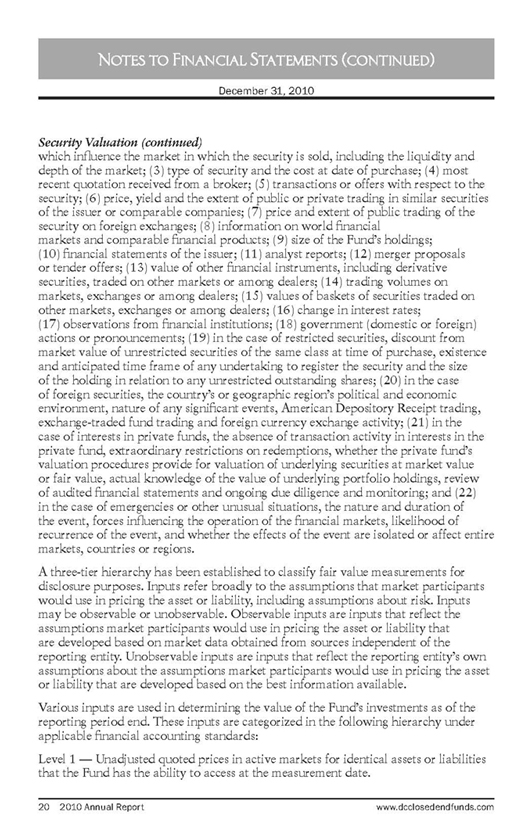
December 31, 2010
Security Valuation (continued)
which influence the market in which the security is sold, including the liquidity and depth of the market; (3) type of security and the cost at date of purchase; (4) most recent quotation received from a broker; (5) transactions or offers with respect to the security; (6) price, yield and the extent of public or private trading in similar securities of the issuer or comparable companies; (7) price and extent of public trading of the security on foreign exchanges; (8) information on world financial markets and comparable financial products; (9) size of the Fund’s holdings; (10) financial statements of the issuer; (11) analyst reports; (12) merger proposals or tender offers; (13) value of other financial instruments, including derivative securities, traded on other markets or among dealers; (14) trading volumes on markets, exchanges or among dealers; (15) values of baskets of securities traded on other markets, exchanges or among dealers; (16) change in interest rates; (17) observations from financial institutions; (18) government (domestic or foreign) actions or pronouncements; (19) in the case of restricted securities, discount from market value of unrestricted securities of the same class at time of purchase, existence and anticipated time frame of any undertaking to register the security and the size of the holding in relation to any unrestricted outstanding shares; (20) in the case of foreign securities, the country’s or geographic region’s political and economic environment, nature of any significant events, American Depository Receipt trading, exchange-traded fund trading and foreign currency exchange activity; (21) in the case of interests in private funds, the absence of transaction activity in interests in the private fund, extraordinary restrictions on redemptions, whether the private fund’s valuation procedures provide for valuation of underlying securities at market value or fair value, actual knowledge of the value of underlying portfolio holdings, review of audited financial statements and ongoing due diligence and monitoring; and (22) in the case of emergencies or other unusual situations, the nature and duration of the event, forces influencing the operation of the financial markets, likelihood of recurrence of the event, and whether the effects of the event are isolated or affect entire markets, countries or regions.
A three-tier hierarchy has been established to classify fair value measurements for disclosure purposes. Inputs refer broadly to the assumptions that market participants would use in pricing the asset or liability, including assumptions about risk. Inputs may be observable or unobservable. Observable inputs are inputs that reflect the assumptions market participants would use in pricing the asset or liability that are developed based on market data obtained from sources independent of the reporting entity. Unobservable inputs are inputs that reflect the reporting entity’s own assumptions about the assumptions market participants would use in pricing the asset or liability that are developed based on the best information available.
Various inputs are used in determining the value of the Fund’s investments as of the reporting period end. These inputs are categorized in the following hierarchy under applicable financial accounting standards:
Level 1 — Unadjusted quoted prices in active markets for identical assets or liabilities that the Fund has the ability to access at the measurement date.
20 2010 Annual Report www.dcclosedendfunds.com

December 31, 2010
Security Valuation (continued)
Level 2 — Observable inputs other than quoted prices included in Level 1 that are observable for the asset or liability, either directly or indirectly. These inputs may include quoted prices for the identical instrument on an inactive market, prices for similar instruments, interest rates, prepayment speeds, credit risk, yield curves, default rates and similar data.
Level 3 — Unobservable inputs for the assets or liability, to the extent relevant observable inputs are not available, representing the Fund’s own assumptions about the assumptions a market participant would use in valuing the asset or liability, and would be based on the best information available.
The following is a summary of the inputs used to value the Funds’ investments as of December 31, 2010.
Level 2 —
Other Level 3 —
Significant Significant
Level 1 — Observable Unobservable
Investments in Securities at Value Quoted Prices Inputs Inputs Total
Common Stock(a) $82,645,437 $— $— $82,645,437
Preferred Stock(a) 13,932,397 136 — 13,932,533
Commercial Real Estate Collateralized
Debt Obligations — 39,500 75 39,575
Collateralized Loan Obligations — 7,457,000 — 7,457,000
Money Market Funds 7,725,354 — — 7,725,354
Total $104,303,188 $7,496,636 $75 $111,799,899
The following is a reconciliation of assets in which significant unobservable inputs (Level 3) were used in determining fair value:
Change in Transfer
Investments Balance Realized unrealized Net in and/ Balance
in Securities as of gain/ appreciation/ purchases/ or out of as of
at Value 12/31/2009 (loss) (depreciation) (sales) Level 3 12/31/2010
Commercial Real Estate Collateralized Debt Obligations $— $— $— $— $75 $75
Total $— $— $— $— $75 $75
(a) | | For detailed descriptions of sectors see the accompanying Statement of Investments. |
1.866.324.7348 2010 Annual Report 21
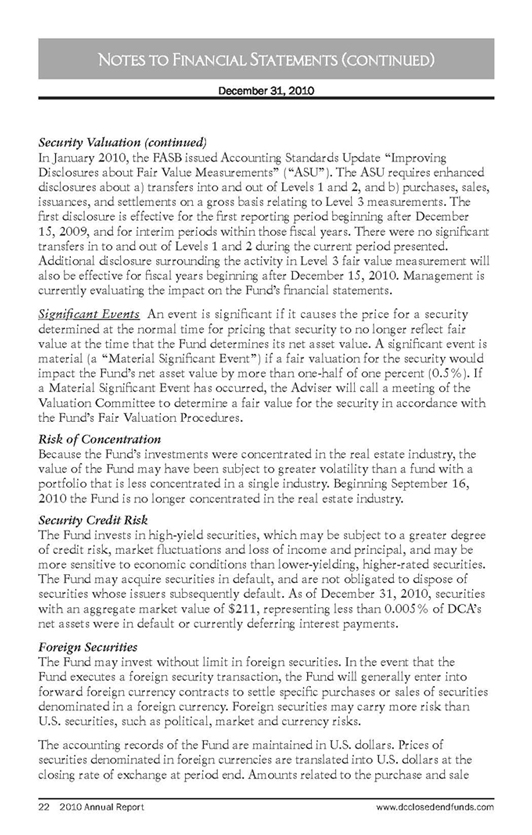
December 31, 2010
Security Valuation (continued)
In January 2010, the FASB issued Accounting Standards Update “Improving Disclosures about Fair Value Measurements” (“ASU”). The ASU requires enhanced disclosures about a) transfers into and out of Levels 1 and 2, and b) purchases, sales, issuances, and settlements on a gross basis relating to Level 3 measurements. The first disclosure is effective for the first reporting period beginning after December 15, 2009, and for interim periods within those fiscal years. There were no significant transfers in to and out of Levels 1 and 2 during the current period presented. Additional disclosure surrounding the activity in Level 3 fair value measurement will also be effective for fiscal years beginning after December 15, 2010. Management is currently evaluating the impact on the Fund’s financial statements.
Signigficant Events An event is significant if it causes the price for a security determined at the normal time for pricing that security to no longer reflect fair value at the time that the Fund determines its net asset value. A significant event is material (a “Material Significant Event”) if a fair valuation for the security would impact the Fund’s net asset value by more than one-half of one percent (0.5%). If a Material Significant Event has occurred, the Adviser will call a meeting of the Valuation Committee to determine a fair value for the security in accordance with the Fund’s Fair Valuation Procedures.
Risk of Concentration
Because the Fund’s investments were concentrated in the real estate industry, the value of the Fund may have been subject to greater volatility than a fund with a portfolio that is less concentrated in a single industry. Beginning September 16, 2010 the Fund is no longer concentrated in the real estate industry.
Security Credit Risk
The Fund invests in high-yield securities, which may be subject to a greater degree of credit risk, market fluctuations and loss of income and principal, and may be more sensitive to economic conditions than lower-yielding, higher-rated securities. The Fund may acquire securities in default, and are not obligated to dispose of securities whose issuers subsequently default. As of December 31, 2010, securities with an aggregate market value of $211, representing less than 0.005% of DCA’s net assets were in default or currently deferring interest payments.
Foreign Securities
The Fund may invest without limit in foreign securities. In the event that the Fund executes a foreign security transaction, the Fund will generally enter into forward foreign currency contracts to settle specific purchases or sales of securities denominated in a foreign currency. Foreign securities may carry more risk than U.S. securities, such as political, market and currency risks.
The accounting records of the Fund are maintained in U.S. dollars. Prices of securities denominated in foreign currencies are translated into U.S. dollars at the closing rate of exchange at period end. Amounts related to the purchase and sale
22 2010 Annual Report www.dcclosedendfunds.com
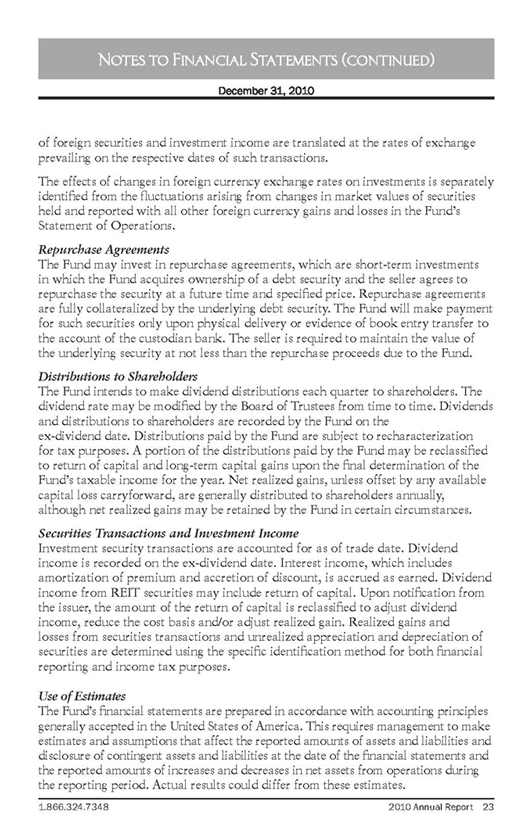
December 31, 2010
of foreign securities and investment income are translated at the rates of exchange prevailing on the respective dates of such transactions.
The effects of changes in foreign currency exchange rates on investments is separately identified from the fluctuations arising from changes in market values of securities held and reported with all other foreign currency gains and losses in the Fund’s Statement of Operations.
Repurchase Agreements
The Fund may invest in repurchase agreements, which are short-term investments in which the Fund acquires ownership of a debt security and the seller agrees to repurchase the security at a future time and specified price. Repurchase agreements are fully collateralized by the underlying debt security. The Fund will make payment for such securities only upon physical delivery or evidence of book entry transfer to the account of the custodian bank. The seller is required to maintain the value of the underlying security at not less than the repurchase proceeds due to the Fund.
Distributions to Shareholders
The Fund intends to make dividend distributions each quarter to shareholders. The
dividend rate may be modified by the Board of Trustees from time to time. Dividends
and distributions to shareholders are recorded by the Fund on the
ex-dividend date. Distributions paid by the Fund are subject to recharacterization
for tax purposes. A portion of the distributions paid by the Fund may be reclassified
to return of capital and long-term capital gains upon the final determination of the
Fund’s taxable income for the year. Net realized gains, unless offset by any available
capital loss carryforward, are generally distributed to shareholders annually,
although net realized gains may be retained by the Fund in certain circumstances.
Securities Transactions and Investment Income
Investment security transactions are accounted for as of trade date. Dividend income is recorded on the ex-dividend date. Interest income, which includes amortization of premium and accretion of discount, is accrued as earned. Dividend income from REIT securities may include return of capital. Upon notification from the issuer, the amount of the return of capital is reclassified to adjust dividend income, reduce the cost basis and/or adjust realized gain. Realized gains and losses from securities transactions and unrealized appreciation and depreciation of securities are determined using the specific identification method for both financial reporting and income tax purposes.
Use of Estimates
The Fund’s financial statements are prepared in accordance with accounting principles generally accepted in the United States of America. This requires management to make estimates and assumptions that affect the reported amounts of assets and liabilities and disclosure of contingent assets and liabilities at the date of the financial statements and the reported amounts of increases and decreases in net assets from operations during the reporting period. Actual results could differ from these estimates.
1.866.324.7348 2010 Annual Report 23
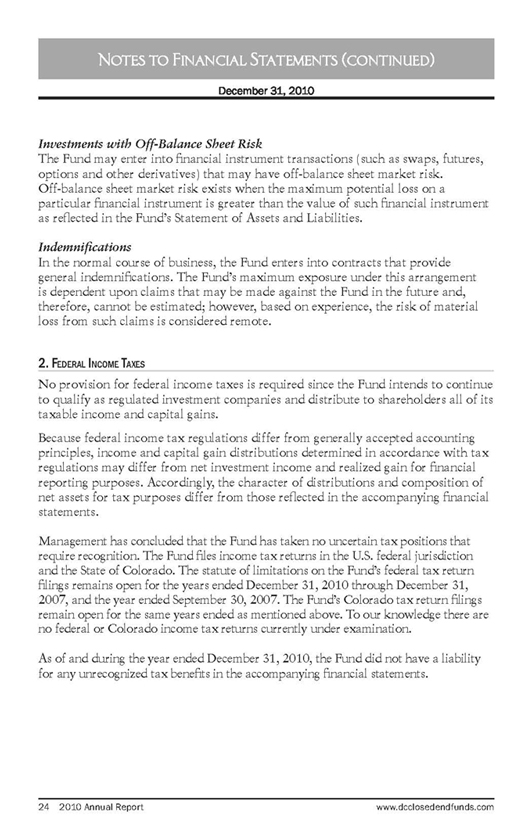
December 31, 2010
Investments with Off-Balance Sheet Risk
The Fund may enter into financial instrument transactions (such as swaps, futures, options and other derivatives) that may have off-balance sheet market risk. Off-balance sheet market risk exists when the maximum potential loss on a particular financial instrument is greater than the value of such financial instrument as reflected in the Fund’s Statement of Assets and Liabilities.
Indemnifications
In the normal course of business, the Fund enters into contracts that provide general indemnifications. The Fund’s maximum exposure under this arrangement is dependent upon claims that may be made against the Fund in the future and, therefore, cannot be estimated; however, based on experience, the risk of material loss from such claims is considered remote.
2. Federal Income Taxes
No provision for federal income taxes is required since the Fund intends to continue to qualify as regulated investment companies and distribute to shareholders all of its taxable income and capital gains.
Because federal income tax regulations differ from generally accepted accounting principles, income and capital gain distributions determined in accordance with tax regulations may differ from net investment income and realized gain for financial reporting purposes. Accordingly, the character of distributions and composition of net assets for tax purposes differ from those reflected in the accompanying financial statements.
Management has concluded that the Fund has taken no uncertain tax positions that require recognition. The Fund files income tax returns in the U.S. federal jurisdiction and the State of Colorado. The statute of limitations on the Fund’s federal tax return filings remains open for the years ended December 31, 2010 through December 31, 2007, and the year ended September 30, 2007. The Fund’s Colorado tax return filings remain open for the same years ended as mentioned above. To our knowledge there are no federal or Colorado income tax returns currently under examination.
As of and during the year ended December 31, 2010, the Fund did not have a liability for any unrecognized tax benefits in the accompanying financial statements.
24 2010 Annual Report www.dcclosedendfunds.com
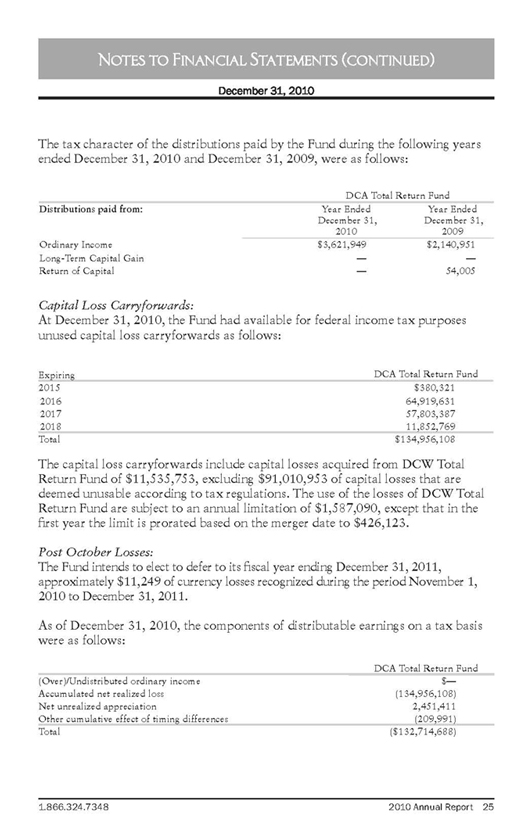
December 31, 2010
The tax character of the distributions paid by the Fund during the following years ended December 31, 2010 and December 31, 2009, were as follows:
DCA Total Return Fund
Distributions paid from: Year Ended Year Ended
December 31, December 31,
2010 2009
Ordinary Income $3,621,949 $2,140,951
Long-Term Capital Gain — —
Return of Capital — 54,005
Capital Loss Carryforwards:
At December 31, 2010, the Fund had available for federal income tax purposes
unused capital loss carryforwards as follows:
Expgiring DCA Total Return Fund
2015 $380,321
64,919,631
57,803,387
11,8,,52,769 Total $134,956,108
The capital loss carryforwards include capital losses acquired from DCW Total Return Fund of $11,535,753, excluding $91,010,953 of capital losses that are deemed unusable according to tax regulations. The use of the losses of DCW Total Return Fund are subject to an annual limitation of $1,587,090, except that in the first year the limit is prorated based on the merger date to $426,123.
Post October Losses:
The Fund intends to elect to defer to its fiscal year ending December 31, 2011, approximately $11,249 of currency losses recognized during the period November 1, 2010 to December 31, 2011.
As of December 31, 2010, the components of distributable earnings on a tax basis were as follows:
DCA Total Return Fund
(Over)/Undistributed ordinary income $—
Accumulated net realized loss (134,956,108)
Net unrealized appreciation 2,451,411
Other cumulative effect of timing differences (209,991)
Total ($132,714,688)
1.866.324.7348 2010 Annual Report 25
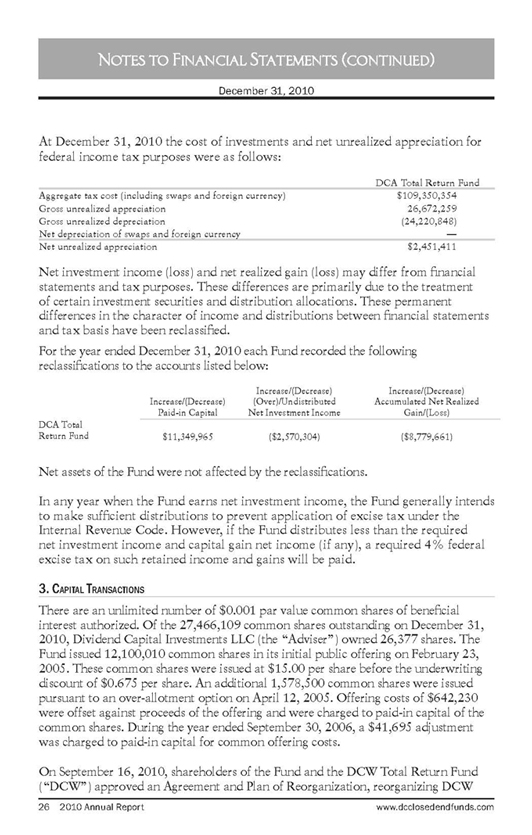
December 31, 2010
At December 31, 2010 the cost of investments and net unrealized appreciation for federal income tax purposes were as follows:
DCA Total Return Fund
Aggregate tax cost (including swaps and foreign currency) $109,350,354
Gross unrealized appreciation 26,672,259
Gross unrealized depreciation (24,220,848)
Net depreciation of swaps and foreign currency —
Net unrealized appreciation $2,451,411
Net investment income (loss) and net realized gain (loss) may differ from financial statements and tax purposes. These differences are primarily due to the treatment of certain investment securities and distribution allocations. These permanent differences in the character of income and distributions between financial statements and tax basis have been reclassified.
For the year ended December 31, 2010 each Fund recorded the following reclassifications to the accounts listed below:
Increase/(Decrease) Increase/(Decrease)
Increase/(Decrease) (Over)/Undistributed Accumulated Net Realized
Paid-in Capital Net Investment Income Gain/(Loss)
DCA Total Return Fund $11,349,965 ($2,570,304) ($8,779,661)
Net assets of the Fund were not affected by the reclassifications.
In any year when the Fund earns net investment income, the Fund generally intends to make suffficient distributions to prevent application of excise tax under the Internal Revenue Code. However, if the Fund distributes less than the required net investment income and capital gain net income (if any), a required 4% federal excise tax on such retained income and gains will be paid.
3. Capital Transactions
There are an unlimited number of $0.001 par value common shares of beneficial interest authorized. Of the 27,466,109 common shares outstanding on December 31, 2010, Dividend Capital Investments LLC (the “Adviser”) owned 26,377 shares. The Fund issued 12,100,010 common shares in its initial public offering on February 23, 2005. These common shares were issued at $15.00 per share before the underwriting discount of $0.675 per share. An additional 1,578,500 common shares were issued pursuant to an over-allotment option on April 12, 2005. Offering costs of $642,230 were offset against proceeds of the offering and were charged to paid-in capital of the common shares. During the year ended September 30, 2006, a $41,695 adjustment was charged to paid-in capital for common offering costs.
On September 16, 2010, shareholders of the Fund and the DCW Total Return Fund (“DCW”) approved an Agreement and Plan of Reorganization, reorganizing DCW
26 2010 Annual Report www.dcclosedendfunds.com
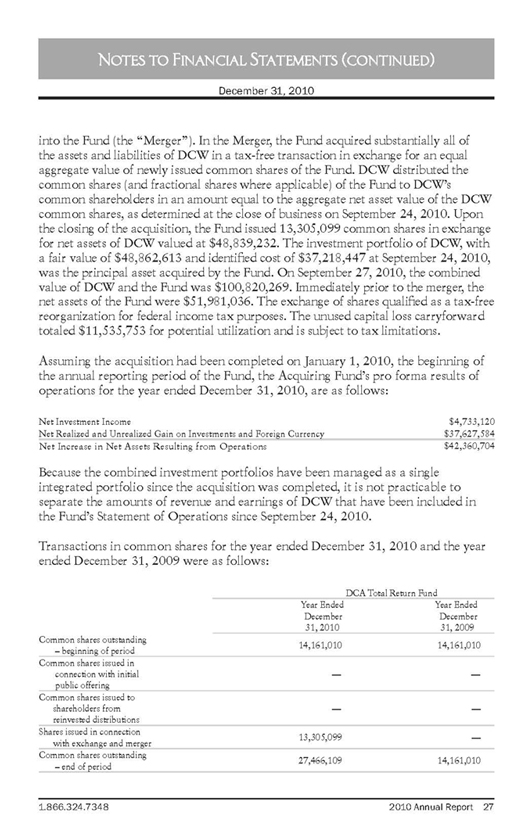
December 31, 2010
into the Fund (the “Merger”). In the Merger, the Fund acquired substantially all of the assets and liabilities of DCW in a tax-free transaction in exchange for an equal aggregate value of newly issued common shares of the Fund. DCW distributed the common shares (and fractional shares where applicable) of the Fund to DCW’s common shareholders in an amount equal to the aggregate net asset value of the DCW common shares, as determined at the close of business on September 24, 2010. Upon the closing of the acquisition, the Fund issued 13,305,099 common shares in exchange for net assets of DCW valued at $48,839,232. The investment portfolio of DCW, with a fair value of $48,862,613 and identified cost of $37,218,447 at September 24, 2010, was the principal asset acquired by the Fund. On September 27, 2010, the combined value of DCW and the Fund was $100,820,269. Immediately prior to the merger, the net assets of the Fund were $51,981,036. The exchange of shares qualified as a tax-free reorganization for federal income tax purposes. The unused capital loss carryforward totaled $11,535,753 for potential utilization and is subject to tax limitations.
Assuming the acquisition had been completed on January 1, 2010, the beginning of the annual reporting period of the Fund, the Acquiring Fund’s pro forma results of operations for the year ended December 31, 2010, are as follows:
Net Investment Income $4,733,120
Net Realized and Unrealized Gain on Investments and Foreign Currency $37,627,584
Net Increase in Net Assets Resulting from Operations $42,360,704
Because the combined investment portfolios have been managed as a single integrated portfolio since the acquisition was completed, it is not practicable to separate the amounts of revenue and earnings of DCW that have been included in the Fund’s Statement of Operations since September 24, 2010.
Transactions in common shares for the year ended December 31, 2010 and the year ended December 31, 2009 were as follows:
DCA Total Return Fund
Year Ended Year Ended
December December
31,2010 31,2009
Common shares outstanding 14,161,010 14,161,010
- beginning of period
Common shares issued in
connection with initial — —
public offering Common shares issued to
shareholders from — —
reinvested distributions Shares issued in connection 13,305,099
with exchange and merger ‘ ‘
Common shares outstanding 27,466,109 14,161,010
- end of period
1.866.324.7348 2010 Annual Report 27
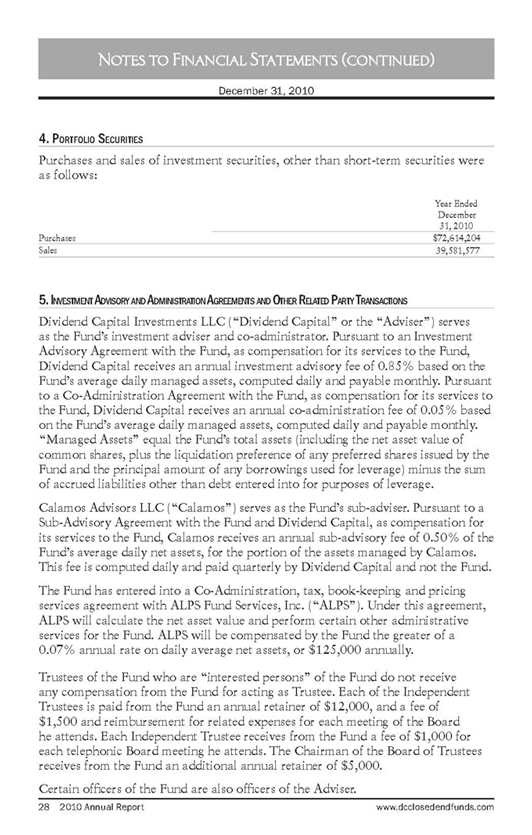
December 31, 2010
4. PortfoLIo Securities
Purchases and sales of investment securities, other than short-term securities were as follows:
Year Ended December 31,2010
Purchases $72,614,204
Sales 39,581,577
5.INVESTMENTADVISORYANDADMINISTRATIONAGR
Dividend Capital Investments LLC (“Dividend Capital” or the “Adviser”) serves as the Fund’s investment adviser and co-administrator. Pursuant to an Investment Advisory Agreement with the Fund, as compensation for its services to the Fund, Dividend Capital receives an annual investment advisory fee of 0.85% based on the Fund’s average daily managed assets, computed daily and payable monthly. Pursuant to a Co-Administration Agreement with the Fund, as compensation for its services to the Fund, Dividend Capital receives an annual co-administration fee of 0.05% based on the Fund’s average daily managed assets, computed daily and payable monthly. “Managed Assets” equal the Fund’s total assets (including the net asset value of common shares, plus the liquidation preference of any preferred shares issued by the Fund and the principal amount of any borrowings used for leverage) minus the sum of accrued liabilities other than debt entered into for purposes of leverage.
Calamos Advisors LLC (“Calamos”) serves as the Fund’s sub-adviser. Pursuant to a Sub-Advisory Agreement with the Fund and Dividend Capital, as compensation for its services to the Fund, Calamos receives an annual sub-advisory fee of 0.50% of the Fund’s average daily net assets, for the portion of the assets managed by Calamos. This fee is computed daily and paid quarterly by Dividend Capital and not the Fund.
The Fund has entered into a Co-Administration, tax, book-keeping and pricing services agreement with ALPS Fund Services, Inc. (“ALPS”). Under this agreement, ALPS will calculate the net asset value and perform certain other administrative services for the Fund. ALPS will be compensated by the Fund the greater of a 0.07% annual rate on daily average net assets, or $125,000 annually.
Trustees of the Fund who are “interested persons” of the Fund do not receive any compensation from the Fund for acting as Trustee. Each of the Independent Trustees is paid from the Fund an annual retainer of $12,000, and a fee of $1,500 and reimbursement for related expenses for each meeting of the Board he attends. Each Independent Trustee receives from the Fund a fee of $1,000 for each telephonic Board meeting he attends. The Chairman of the Board of Trustees receives from the Fund an additional annual retainer of $5,000.
Certain officers of the Fund are also officers of the Adviser.
28 2010 Annual Report www.dcclosedendfunds.com
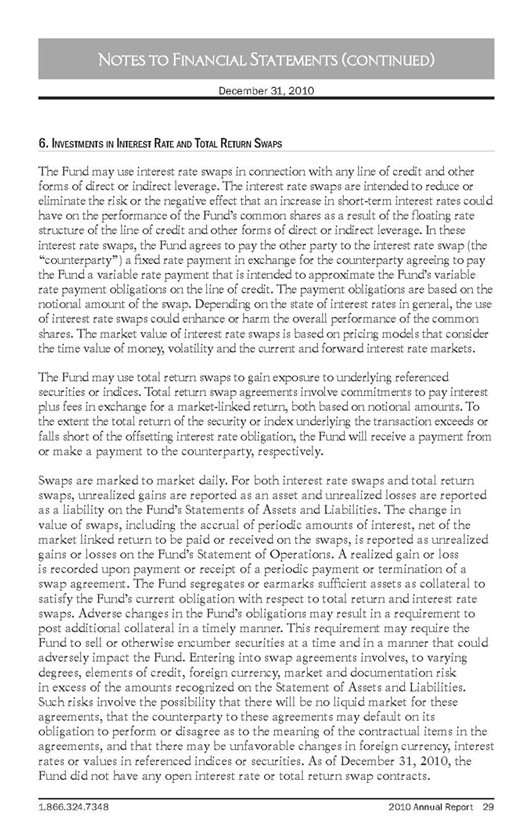
December 31, 2010
6. Investments in Interest Rate and Total Return Swaps
The Fund may use interest rate swaps in connection with any line of credit and other forms of direct or indirect leverage. The interest rate swaps are intended to reduce or eliminate the risk or the negative effect that an increase in short-term interest rates could have on the performance of the Fund’s common shares as a result of the floating rate structure of the line of credit and other forms of direct or indirect leverage. In these interest rate swaps, the Fund agrees to pay the other party to the interest rate swap (the “counterparty”) a fixed rate payment in exchange for the counterparty agreeing to pay the Fund a variable rate payment that is intended to approximate the Fund’s variable rate payment obligations on the line of credit. The payment obligations are based on the notional amount of the swap. Depending on the state of interest rates in general, the use of interest rate swaps could enhance or harm the overall performance of the common shares. The market value of interest rate swaps is based on pricing models that consider the time value of money, volatility and the current and forward interest rate markets.
The Fund may use total return swaps to gain exposure to underlying referenced securities or indices. Total return swap agreements involve commitments to pay interest plus fees in exchange for a market-linked return, both based on notional amounts. To the extent the total return of the security or index underlying the transaction exceeds or falls short of the offsetting interest rate obligation, the Fund will receive a payment from or make a payment to the counterparty, respectively.
Swaps are marked to market daily. For both interest rate swaps and total return swaps, unrealized gains are reported as an asset and unrealized losses are reported as a liability on the Fund’s Statements of Assets and Liabilities. The change in value of swaps, including the accrual of periodic amounts of interest, net of the market linked return to be paid or received on the swaps, is reported as unrealized gains or losses on the Fund’s Statement of Operations. A realized gain or loss is recorded upon payment or receipt of a periodic payment or termination of a swap agreement. The Fund segregates or earmarks sufficient assets as collateral to satisfy the Fund’s current obligation with respect to total return and interest rate swaps. Adverse changes in the Fund’s obligations may result in a requirement to post additional collateral in a timely manner. This requirement may require the Fund to sell or otherwise encumber securities at a time and in a manner that could adversely impact the Fund. Entering into swap agreements involves, to varying degrees, elements of credit, foreign currency, market and documentation risk in excess of the amounts recognized on the Statement of Assets and Liabilities. Such risks involve the possibility that there will be no liquid market for these agreements, that the counterparty to these agreements may default on its obligation to perform or disagree as to the meaning of the contractual items in the agreements, and that there may be unfavorable changes in foreign currency, interest rates or values in referenced indices or securities. As of December 31, 2010, the Fund did not have any open interest rate or total return swap contracts.
1.866.324.7348 2010 Annual Report 29
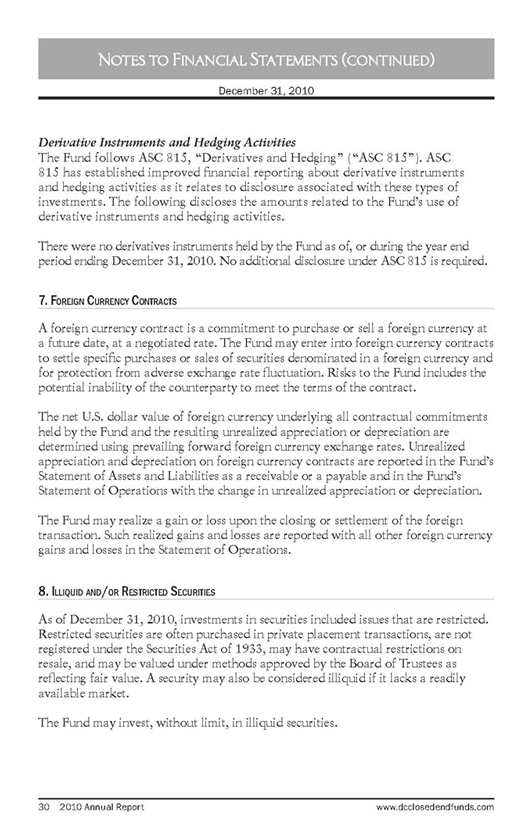
December 31, 2010
Derivative Instruments and Hedging Activities
The Fund follows ASC 815, “Derivatives and Hedging” (“ASC 815”). ASC 815 has established improved financial reporting about derivative instruments and hedging activities as it relates to disclosure associated with these types of investments. The following discloses the amounts related to the Fund’s use of derivative instruments and hedging activities.
There were no derivatives instruments held by the Fund as of, or during the year end period ending December 31,2010. No additional disclosure under ASC 815 is required.
7. Foreign Currency Contracts
A foreign currency contract is a commitment to purchase or sell a foreign currency at a future date, at a negotiated rate. The Fund may enter into foreign currency contracts to settle specific purchases or sales of securities denominated in a foreign currency and for protection from adverse exchange rate fluctuation. Risks to the Fund includes the potential inability of the counterparty to meet the terms of the contract.
The net U.S. dollar value of foreign currency underlying all contractual commitments held by the Fund and the resulting unrealized appreciation or depreciation are determined using prevailing forward foreign currency exchange rates. Unrealized appreciation and depreciation on foreign currency contracts are reported in the Fund’s Statement of Assets and Liabilities as a receivable or a payable and in the Fund’s Statement of Operations with the change in unrealized appreciation or depreciation.
The Fund may realize a gain or loss upon the closing or settlement of the foreign transaction. Such realized gains and losses are reported with all other foreign currency gains and losses in the Statement of Operations.
8. Illiquid and/or Restricted Securities
As of December 31,2010, investments in securities included issues that are restricted. Restricted securities are often purchased in private placement transactions, are not registered under the Securities Act of 1933, may have contractual restrictions on resale, and may be valued under methods approved by the Board of Trustees as reflecting fair value. A security may also be considered illiquid if it lacks a readily available market.
The Fund may invest, without limit, in illiquid securities.
30 2010 Annual Report www.dcclosedendfunds.com
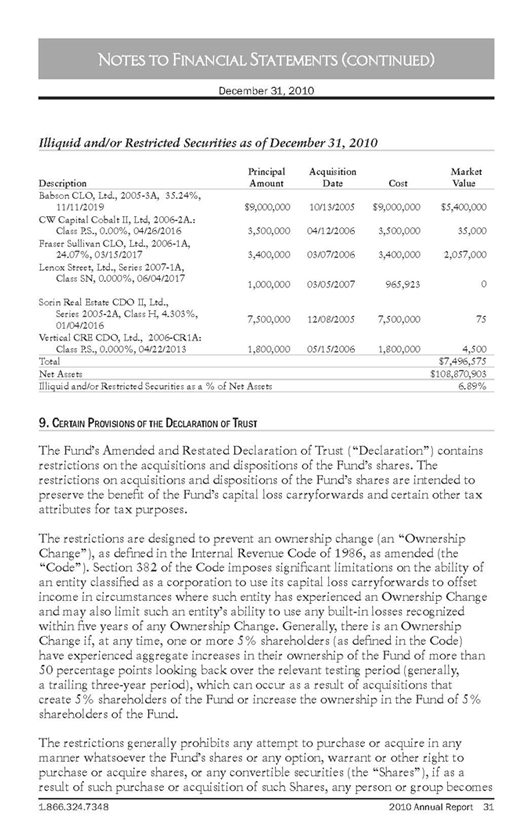
December 31, 2010 Illiquid and/or Restricted Securities as of December 31, 2010
Principal Acquisition Market
Description Amount Date Cost Value
Babson CLO, Ltd., 2005-3A, 35.24%,
11/11/2019 $9,000,000 10/13/2005 $9,000,000 $5,400,000
CW Capital Cobalt II, Ltd, 2006-2A.:
Class P.S., 0.00%, 04/26/2016 3,500,000 04/12/2006 3,500,000 35,000
Fraser Sullivan CLO, Ltd., 2006-1A,
24.07%, 03/15/2017 3,400,000 03/07/2006 3,400,000 2,057,000
Lenox Street, Ltd., Series 2007-1A,
Class SN, 0.000%, 06/04/2017 1,000,000 03/05/2007 956,923 0
Sorin Real Estate CDO II, Ltd.,
Series 2005-2A,ClassH,4.303%, 7,500,000 12/08/2005 7,500,000 75
Vertical CRE CDO, Ltd., 2006-CR1A:
Class P.S., 0.000%, 04/22/2013 1,800,000 05/15/2006 1,800,000 4,500
Total $7,496,575
Net Assets $108,870,903
Illiquid and/or Restricted Securities as a % of Net Assets 6.89%
9. Certain Provisions of the Declaration of Trust
The Fund’s Amended and Restated Declaration of Trust (“Declaration”) contains restrictions on the acquisitions and dispositions of the Fund’s shares. The restrictions on acquisitions and dispositions of the Fund’s shares are intended to preserve the benefit of the Fund’s capital loss carryforwards and certain other tax attributes for tax purposes.
The restrictions are designed to prevent an ownership change (an “Ownership Change”), as defined in the Internal Revenue Code of 1986, as amended (the “Code”). Section 382 of the Code imposes significant limitations on the ability of an entity classified as a corporation to use its capital loss carryforwards to offset income in circumstances where such entity has experienced an Ownership Change and may also limit such an entity’s ability to use any built-in losses recognized within five years of any Ownership Change. Generally, there is an Ownership Change if, at any time, one or more 5% shareholders (as defined in the Code) have experienced aggregate increases in their ownership of the Fund of more than 50 percentage points looking back over the relevant testing period (generally, a trailing three-year period), which can occur as a result of acquisitions that create 5% shareholders of the Fund or increase the ownership in the Fund of 5% shareholders of the Fund.
The restrictions generally prohibits any attempt to purchase or acquire in any manner whatsoever the Fund’s shares or any option, warrant or other right to purchase or acquire shares, or any convertible securities (the “Shares”), if as a result of such purchase or acquisition of such Shares, any person or group becomes
1.866.324.7348 2010 Annual Report 31
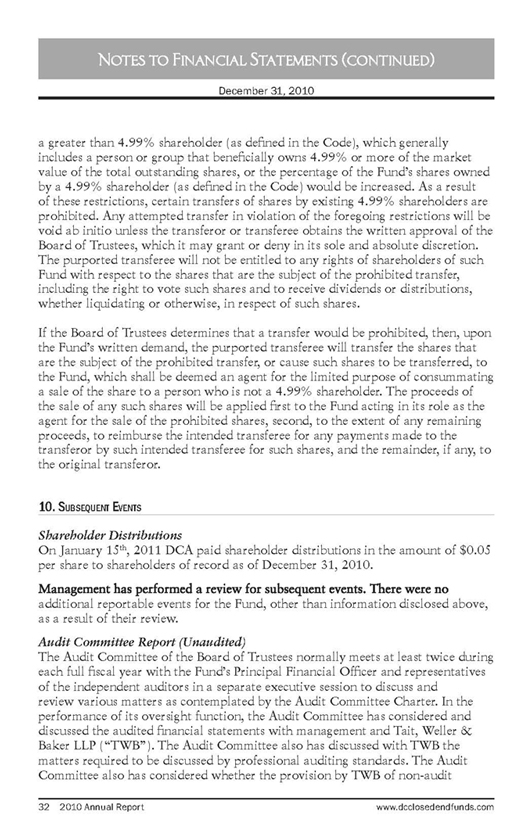
December 31, 2010
a greater than 4.99% shareholder (as defined in the Code), which generally includes a person or group that beneficially owns 4.99% or more of the market value of the total outstanding shares, or the percentage of the Fund’s shares owned by a 4.99% shareholder (as defined in the Code) would be increased. As a result of these restrictions, certain transfers of shares by existing 4.99% shareholders are prohibited. Any attempted transfer in violation of the foregoing restrictions will be void ab initio unless the transferor or transferee obtains the written approval of the Board of Trustees, which it may grant or deny in its sole and absolute discretion. The purported transferee will not be entitled to any rights of shareholders of such Fund with respect to the shares that are the subject of the prohibited transfer, including the right to vote such shares and to receive dividends or distributions, whether liquidating or otherwise, in respect of such shares.
If the Board of Trustees determines that a transfer would be prohibited, then, upon the Fund’s written demand, the purported transferee will transfer the shares that are the subject of the prohibited transfer, or cause such shares to be transferred, to the Fund, which shall be deemed an agent for the limited purpose of consummating a sale of the share to a person who is not a 4.99% shareholder. The proceeds of the sale of any such shares will be applied first to the Fund acting in its role as the agent for the sale of the prohibited shares, second, to the extent of any remaining proceeds, to reimburse the intended transferee for any payments made to the transferor by such intended transferee for such shares, and the remainder, if any, to the original transferor.
Shareholder Distributions
On January 15th, 2011 DCA paid shareholder distributions in the amount of $0.05 per share to shareholders of record as of December 31, 2010.
Management has performed a review for subsequent events. There were no additional reportable events for the Fund, other than information disclosed above, as a result of their review.
Audit Committee Report (Unaudited)
The Audit Committee of the Board of Trustees normally meets at least twice during each full fiscal year with the Fund’s Principal Financial Offficer and representatives of the independent auditors in a separate executive session to discuss and review various matters as contemplated by the Audit Committee Charter. In the performance of its oversight function, the Audit Committee has considered and discussed the audited financial statements with management and Tait, Weller & Baker LLP (“TWB”). The Audit Committee also has discussed with TWB the matters required to be discussed by professional auditing standards. The Audit Committee also has considered whether the provision by TWB of non-audit
32 2010 Annual Report www.dcclosedendfunds.com
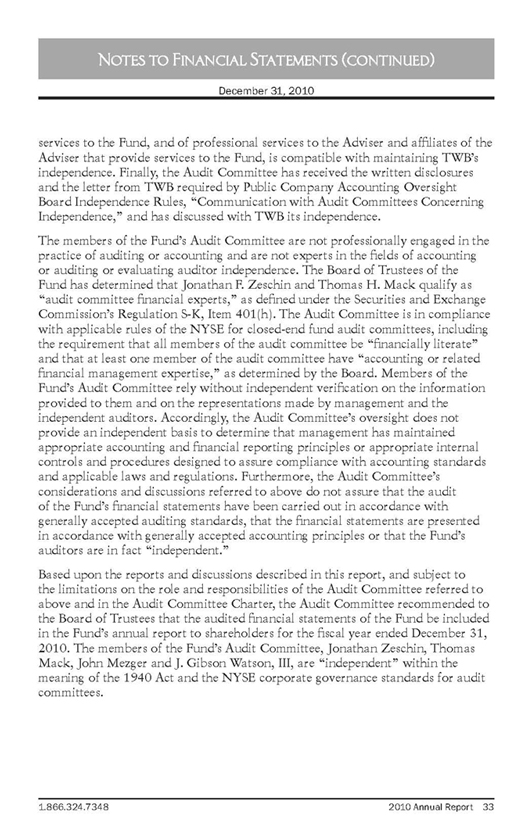
December 31, 2010
services to the Fund, and of professional services to the Adviser and afffiliates of the Adviser that provide services to the Fund, is compatible with maintaining TWB’s independence. Finally, the Audit Committee has received the written disclosures and the letter from TWB required by Public Company Accounting Oversight Board Independence Rules, “Communication with Audit Committees Concerning Independence,” and has discussed with TWB its independence.
The members of the Fund’s Audit Committee are not professionally engaged in the practice of auditing or accounting and are not experts in the fields of accounting or auditing or evaluating auditor independence. The Board of Trustees of the Fund has determined that Jonathan F. Zeschin and Thomas H. Mack qualify as “audit committee financial experts,” as defined under the Securities and Exchange Commission’s Regulation S-K, Item 401 (h). The Audit Committee is in compliance with applicable rules of the NYSE for closed-end fund audit committees, including the requirement that all members of the audit committee be “financially literate” and that at least one member of the audit committee have “accounting or related financial management expertise,” as determined by the Board. Members of the Fund’s Audit Committee rely without independent verification on the information provided to them and on the representations made by management and the independent auditors. Accordingly, the Audit Committee’s oversight does not provide an independent basis to determine that management has maintained appropriate accounting and financial reporting principles or appropriate internal controls and procedures designed to assure compliance with accounting standards and applicable laws and regulations. Furthermore, the Audit Committee’s considerations and discussions referred to above do not assure that the audit of the Fund’s financial statements have been carried out in accordance with generally accepted auditing standards, that the financial statements are presented in accordance with generally accepted accounting principles or that the Fund’s auditors are in fact “independent.”
Based upon the reports and discussions described in this report, and subject to the limitations on the role and responsibilities of the Audit Committee referred to above and in the Audit Committee Charter, the Audit Committee recommended to the Board of Trustees that the audited financial statements of the Fund be included in the Fund’s annual report to shareholders for the fiscal year ended December 31, 2010. The members of the Fund’s Audit Committee, Jonathan Zeschin, Thomas Mack, John Mezger and J. Gibson Watson, III, are “independent” within the meaning of the 1940 Act and the NYSE corporate governance standards for audit committees.
1.866.324.7348 2010 Annual Report 33
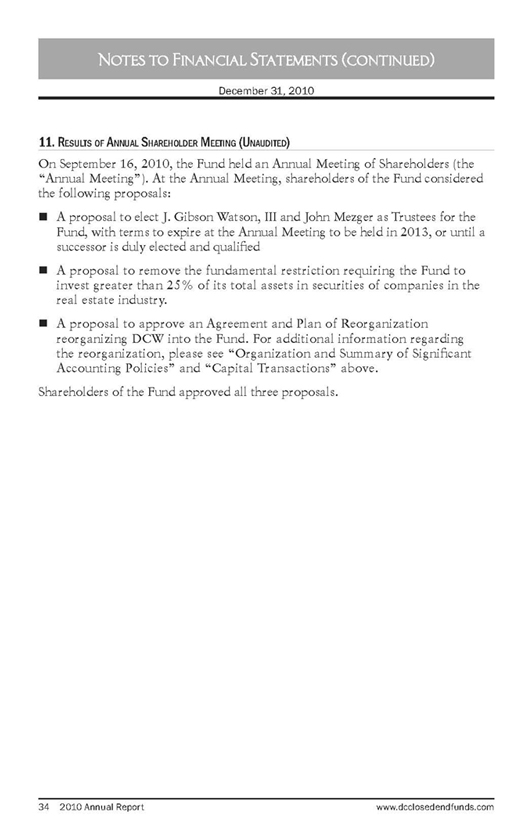
December 31, 2010
11. | | Results of Annual Shareholder Meeting (Unaudited) |
On September 16, 2010, the Fund held an Annual Meeting of Shareholders (the “Annual Meeting”). At the Annual Meeting, shareholders of the Fund considered the following proposals:
A proposal to elect J. Gibson Watson, III and John Mezger as Trustees for the Fund, with terms to expire at the Annual Meeting to be held in 2013, or until a successor is duly elected and qualified
A proposal to remove the fundamental restriction requiring the Fund to invest greater than 25% of its total assets in securities of companies in the real estate industry.
A proposal to approve an Agreement and Plan of Reorganization reorganizing DCW into the Fund. For additional information regarding the reorganization, please see “Organization and Summary of Significant Accounting Policies” and “Capital Transactions” above.
Shareholders of the Fund approved all three proposals.
34 2010 Annual Report www.dcclosedendfunds.com
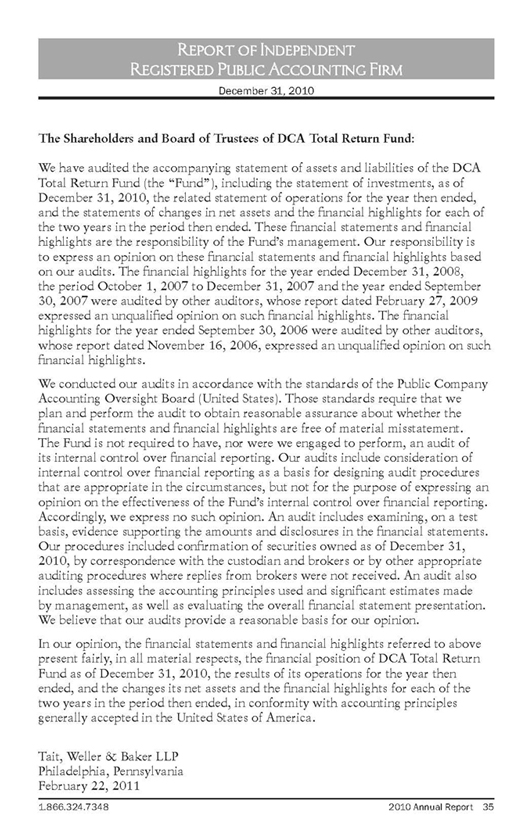
December 31, 2010
The Shareholders and Board of Trustees of DCA Total Return Fund:
We have audited the accompanying statement of assets and liabilities of the DCA Total Return Fund (the “Fund”), including the statement of investments, as of December 31, 2010, the related statement of operations for the year then ended, and the statements of changes in net assets and the financial highlights for each of the two years in the period then ended. These financial statements and financial highlights are the responsibility of the Fund’s management. Our responsibility is to express an opinion on these financial statements and financial highlights based on our audits. The financial highlights for the year ended December 31, 2008, the period October 1, 2007 to December 31, 2007 and the year ended September 30, 2007 were audited by other auditors, whose report dated February 27, 2009 expressed an unqualified opinion on such financial highlights. The financial highlights for the year ended September 30, 2006 were audited by other auditors, whose report dated November 16, 2006, expressed an unqualified opinion on such financial highlights.
We conducted our audits in accordance with the standards of the Public Company Accounting Oversight Board (United States). Those standards require that we plan and perform the audit to obtain reasonable assurance about whether the financial statements and financial highlights are free of material misstatement. The Fund is not required to have, nor were we engaged to perform, an audit of its internal control over financial reporting. Our audits include consideration of internal control over financial reporting as a basis for designing audit procedures that are appropriate in the circumstances, but not for the purpose of expressing an opinion on the effectiveness of the Fund’s internal control over financial reporting. Accordingly, we express no such opinion. An audit includes examining, on a test basis, evidence supporting the amounts and disclosures in the financial statements. Our procedures included confirmation of securities owned as of December 31, 2010, by correspondence with the custodian and brokers or by other appropriate auditing procedures where replies from brokers were not received. An audit also includes assessing the accounting principles used and significant estimates made by management, as well as evaluating the overall financial statement presentation. We believe that our audits provide a reasonable basis for our opinion.
In our opinion, the financial statements and financial highlights referred to above present fairly, in all material respects, the financial position of DCA Total Return Fund as of December 31, 2010, the results of its operations for the year then ended, and the changes its net assets and the financial highlights for each of the two years in the period then ended, in conformity with accounting principles generally accepted in the United States of America.
Tait, Weller & Baker LLP Philadelphia, Pennsylvania February 22, 2011
1.866.324.7348 2010 Annual Report 35
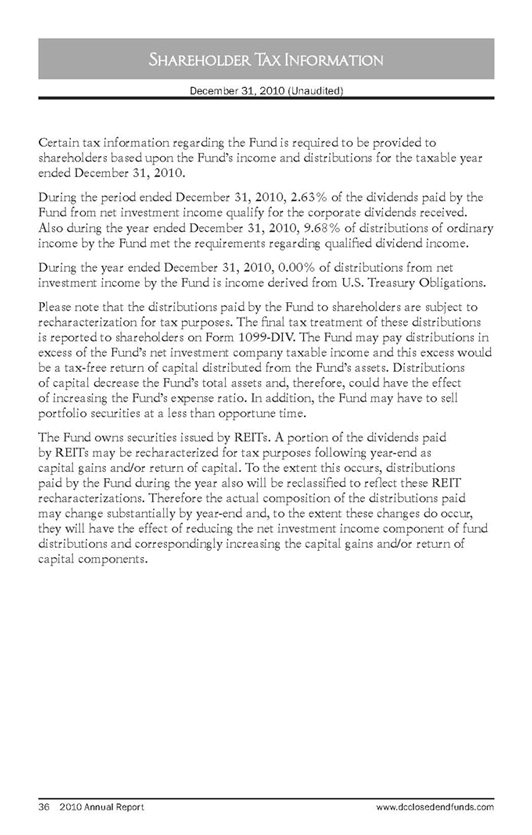
December 31, 2010 (Unaudited)
Certain tax information regarding the Fund is required to be provided to shareholders based upon the Fund’s income and distributions for the taxable year ended December 31, 2010.
During the period ended December 31, 2010, 2.63% of the dividends paid by the Fund from net investment income qualify for the corporate dividends received. Also during the year ended December 31, 2010, 9.68% of distributions of ordinary income by the Fund met the requirements regarding qualified dividend income.
During the year ended December 31, 2010, 0.00% of distributions from net investment income by the Fund is income derived from U.S. Treasury Obligations.
Please note that the distributions paid by the Fund to shareholders are subject to recharacterization for tax purposes. The final tax treatment of these distributions is reported to shareholders on Form 1099-DIV. The Fund may pay distributions in excess of the Fund’s net investment company taxable income and this excess would be a tax-free return of capital distributed from the Fund’s assets. Distributions of capital decrease the Fund’s total assets and, therefore, could have the effect of increasing the Fund’s expense ratio. In addition, the Fund may have to sell portfolio securities at a less than opportune time.
The Fund owns securities issued by REITs. A portion of the dividends paid by REITs may be recharacterized for tax purposes following year-end as capital gains and/or return of capital. To the extent this occurs, distributions paid by the Fund during the year also will be reclassified to reflect these REIT recharacterizations. Therefore the actual composition of the distributions paid may change substantially by year-end and, to the extent these changes do occur, they will have the effect of reducing the net investment income component of fund distributions and correspondingly increasing the capital gains and/or return of capital components.
36 2010 Annual Report www.dcclosedendfunds.com
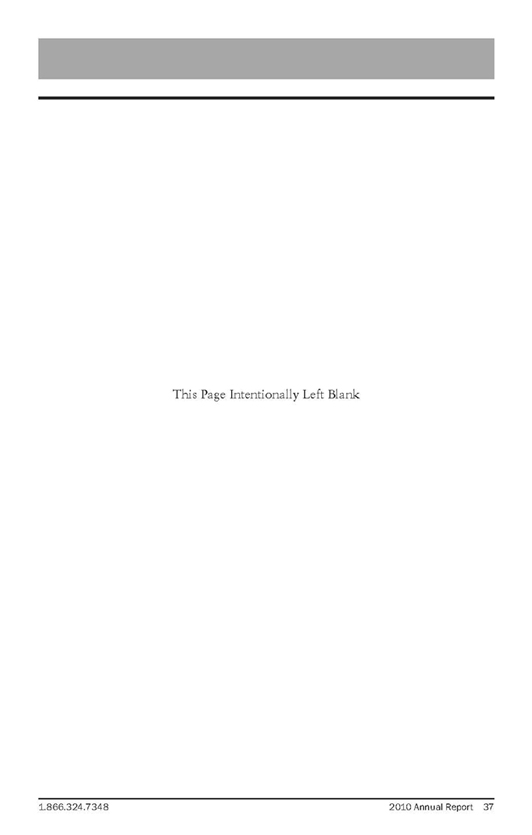
This Page Intentionally Left Blank
1.866.324.7348 2010 Annual Report 37
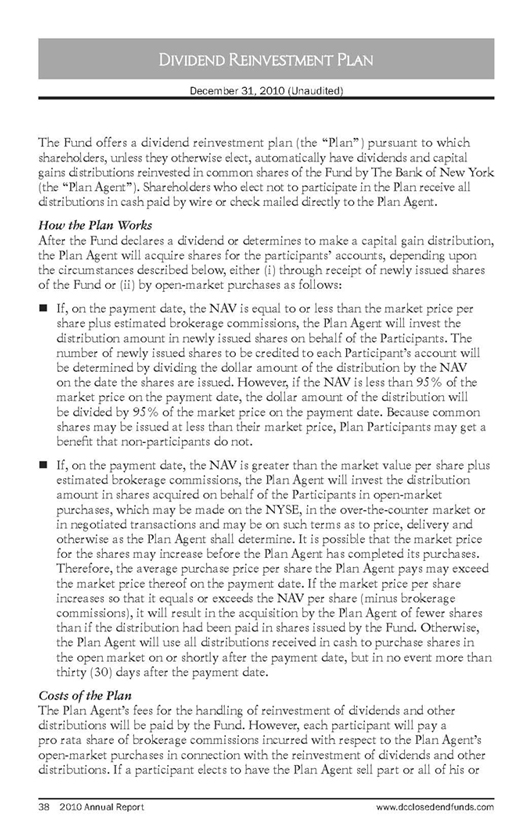
December 31, 2010 (Unaudited)
The Fund offers a dividend reinvestment plan (the “Plan”) pursuant to which shareholders, unless they otherwise elect, automatically have dividends and capital gains distributions reinvested in common shares of the Fund by The Bank of New York (the “Plan Agent”). Shareholders who elect not to participate in the Plan receive all distributions in cash paid by wire or check mailed directly to the Plan Agent.
How the Plan Works
After the Fund declares a dividend or determines to make a capital gain distribution, the Plan Agent will acquire shares for the participants’ accounts, depending upon the circumstances described below, either (i) through receipt of newly issued shares of the Fund or (ii) by open-market purchases as follows:
If, on the payment date, the NAV is equal to or less than the market price per share plus estimated brokerage commissions, the Plan Agent will invest the distribution amount in newly issued shares on behalf of the Participants. The number of newly issued shares to be credited to each Participant’s account will be determined by dividing the dollar amount of the distribution by the NAV on the date the shares are issued. However, if the NAV is less than 95% of the market price on the payment date, the dollar amount of the distribution will be divided by 95% of the market price on the payment date. Because common shares may be issued at less than their market price, Plan Participants may get a benefit that non-participants do not.
If, on the payment date, the NAV is greater than the market value per share plus estimated brokerage commissions, the Plan Agent will invest the distribution amount in shares acquired on behalf of the Participants in open-market purchases, which may be made on the NYSE, in the over-the-counter market or in negotiated transactions and may be on such terms as to price, delivery and otherwise as the Plan Agent shall determine. It is possible that the market price for the shares may increase before the Plan Agent has completed its purchases. Therefore, the average purchase price per share the Plan Agent pays may exceed the market price thereof on the payment date. If the market price per share increases so that it equals or exceeds the NAV per share (minus brokerage commissions), it will result in the acquisition by the Plan Agent of fewer shares than if the distribution had been paid in shares issued by the Fund. Otherwise, the Plan Agent will use all distributions received in cash to purchase shares in the open market on or shortly after the payment date, but in no event more than thirty (30) days after the payment date.
Costs of the Plan
The Plan Agent’s fees for the handling of reinvestment of dividends and other
distributions will be paid by the Fund. However, each participant will pay a
pro rata share of brokerage commissions incurred with respect to the Plan Agent’s
open-market purchases in connection with the reinvestment of dividends and other
distributions. If a participant elects to have the Plan Agent sell part or all of his or
38 2010 Annual Report www.dcclosedendfunds.com
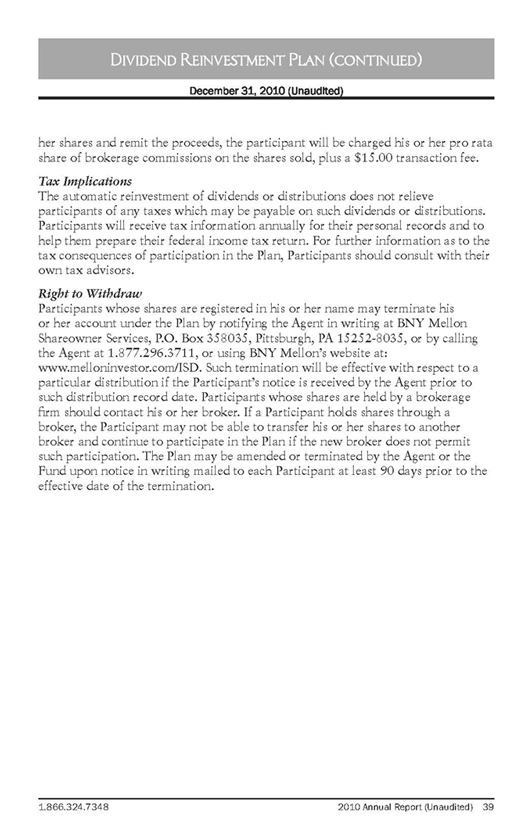
December 31, 2010 (Unaudited)
her shares and remit the proceeds, the participant will be charged his or her pro rata share of brokerage commissions on the shares sold, plus a $15.00 transaction fee.
Tax Implications
The automatic reinvestment of dividends or distributions does not relieve participants of any taxes which may be payable on such dividends or distributions. Participants will receive tax information annually for their personal records and to help them prepare their federal income tax return. For further information as to the tax consequences of participation in the Plan, Participants should consult with their own tax advisors.
Right to Withdraw
Participants whose shares are registered in his or her name may terminate his or her account under the Plan by notifying the Agent in writing at BNY Mellon Shareowner Services, P.O. Box 358035, Pittsburgh, PA 15252-8035, or by calling the Agent at 1.877.296.3711, or using BNY Mellon’s website at: www.melloninvestor.com/ISD. Such termination will be effective with respect to a particular distribution if the Participant’s notice is received by the Agent prior to such distribution record date. Participants whose shares are held by a brokerage firm should contact his or her broker. If a Participant holds shares through a broker, the Participant may not be able to transfer his or her shares to another broker and continue to participate in the Plan if the new broker does not permit such participation. The Plan may be amended or terminated by the Agent or the Fund upon notice in writing mailed to each Participant at least 90 days prior to the effective date of the termination.
1.866.324.7348 2010 Annual Report (Unaudited) 39
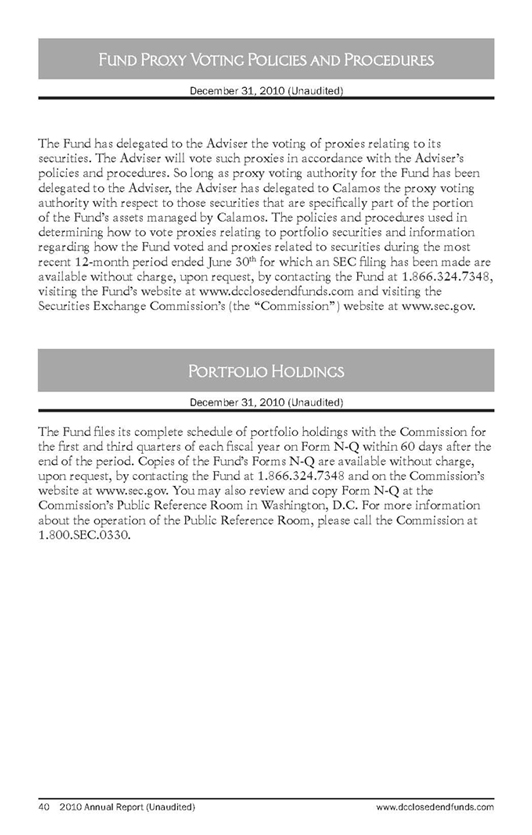
December 31, 2010 (Unaudited)
The Fund has delegated to the Adviser the voting of proxies relating to its securities. The Adviser will vote such proxies in accordance with the Adviser’s policies and procedures. So long as proxy voting authority for the Fund has been delegated to the Adviser, the Adviser has delegated to Calamos the proxy voting authority with respect to those securities that are specifically part of the portion of the Fund’s assets managed by Calamos. The policies and procedures used in determining how to vote proxies relating to portfolio securities and information regarding how the Fund voted and proxies related to securities during the most recent 12-month period ended June 30th for which an SEC filing has been made are available without charge, upon request, by contacting the Fund at 1.866.324.7348, visiting the Fund’s website at www.dcclosedendfunds.com and visiting the Securities Exchange Commission’s (the “Commission”) website at www.sec.gov.
December 31, 2010 (Unaudited)
The Fund files its complete schedule of portfolio holdings with the Commission for the first and third quarters of each fiscal year on Form N-Q within 60 days after the end of the period. Copies of the Fund’s Forms N-Q are available without charge, upon request, by contacting the Fund at 1.866.324.7348 and on the Commission’s website at www.sec.gov. You may also review and copy Form N-Q at the Commission’s Public Reference Room in Washington, D.C. For more information about the operation of the Public Reference Room, please call the Commission at 1.800.SEC.0330.
40 2010 Annual Report (Unaudited) www.dcclosedendfunds.com
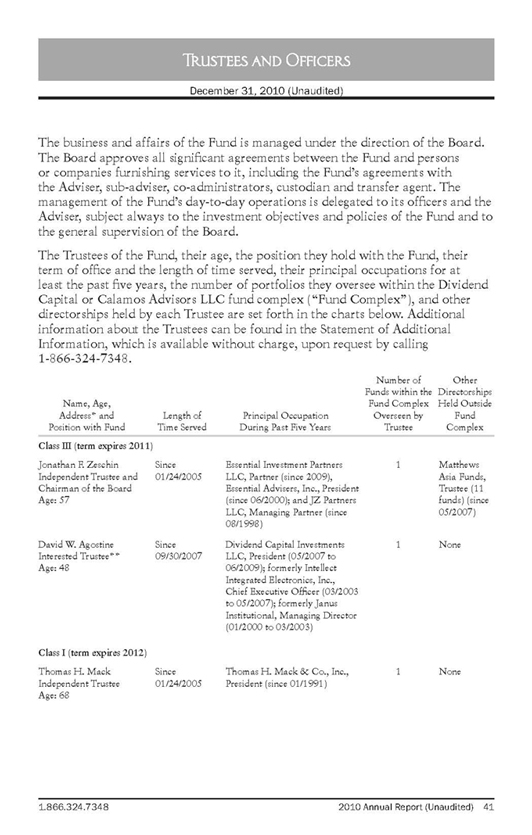
December 31, 2010 (Unaudited)
The business and affairs of the Fund is managed under the direction of the Board. The Board approves all significant agreements between the Fund and persons or companies furnishing services to it, including the Fund’s agreements with the Adviser, sub-adviser, co-administrators, custodian and transfer agent. The management of the Fund’s day-to-day operations is delegated to its officers and the Adviser, subject always to the investment objectives and policies of the Fund and to the general supervision of the Board.
The Trustees of the Fund, their age, the position they hold with the Fund, their term of offfice and the length of time served, their principal occupations for at least the past five years, the number of portfolios they oversee within the Dividend Capital or Calamos Advisors LLC fund complex (“Fund Complex”), and other directorships held by each Trustee are set forth in the charts below. Additional information about the Trustees can be found in the Statement of Additional Information, which is available without charge, upon request by calling 1-866-324-7348.
Number of Other
Funds within the Directorships
Name, Age, Fund Complex Held Outside
Address* and Length of Principal Occupation Overseen by Fund
Position with Fund Time Served During Past Five Years Trustee Complex
Class III (term expires 2011)
Jonathan F. Zeschin Since Essential Investment Partners 1 Matthews
Independent Trustee and 01/24/2005 LLC, Partner (since 2009), Asia Funds,
Chairman of the Board Essential Advisers, Inc., President Trustee (11
Age: 57 (since 06/2000); and JZ Partners funds) (since
LLC, Managing Partner (since 05/2007)
08/1998)
David W. Agostine Since Dividend Capital Investments 1 None
Interested Trustee** 09/30/2007 LLC, President (05/2007 to
Age: 48 06/2009); formerly Intellect
Integrated Electronics, Inc.,
Chief Executive Offficer (03/2003
to 05/2007); formerly Janus
Institutional, Managing Director
(01/2000 to 03/2003)
Class I (term expires 2012)
Thomas H. Mack Since Thomas H. Mack & Co., Inc., 1 None
Independent Trustee 01/24/2005 President (since 01/1991)
Age: 68
1.866.324.7348 2010 Annual Report (Unaudited) 41
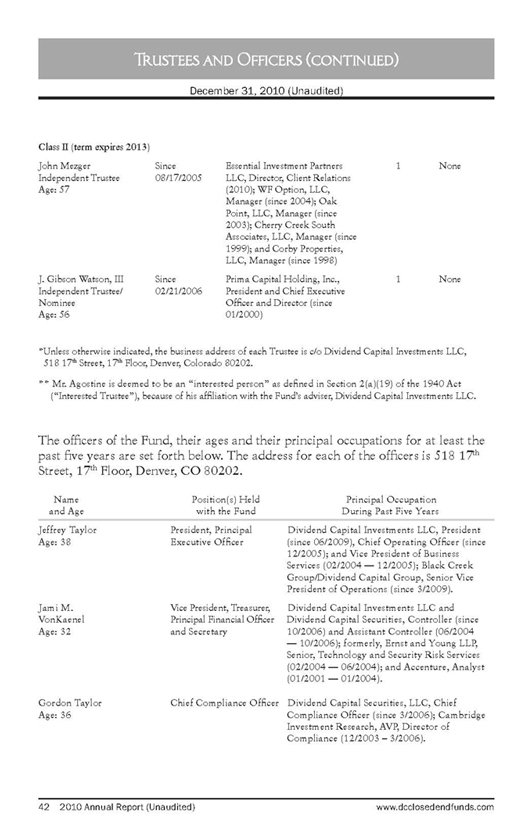
December 31, 2010 (Unaudited)
Class II (term expires 2013)
John Mezger Since Essential Investment Partners 1 None
Independent Trustee 08/17/2005 LLC, Director, Client Relations
Age: 57 (2010); WF Option, LLC,
Manager (since 2004); Oak
Point, LLC, Manager (since
2003); Cherry Creek South
Associates, LLC, Manager (since
1999); and Corby Properties,
LLC, Manager (since 1998)
J. Gibson Watson, III Since Prima Capital Holding, Inc., 1 None
Independent Trustee/ 02/21/2006 President and Chief Executive Nominee Offficer and Director (since
Age: 56 01/2000)
*Unless otherwise indicated, the business address of each Trustee is c/o Dividend Capital Investments LLC, 518 177th Street, 177th Floor, Denver, Colorado 80202.
** Mr. Agostine is deemed to bean “interested person” as defined in Section 2(a)(19) of the 1940 Act (“Interested Trustee”), because of his afffiliation with the Fund’s adviser, Dividend Capital Investments LLC.
The offficers of the Fund, their ages and their principal occupations for at least the past five years are set forth below. The address for each of the offficers is 518 17th Street, 17th Floor, Denver, CO 80202.
Name Position(s) Held Principal Occupation
and Age with the Fund During Past Five Years
Jeffrey Taylor President, Principal Dividend Capital Investments LLC, President
Age: 38 Executive Offficer (since 06/2009), Chief Operating Offficer (since
12/2005); and Vice President of Business Services (02/2004 — 12/2005); Black Creek Group/Dividend Capital Group, Senior Vice President of Operations (since 3/2009).
Jami M. Vice President, Treasurer, Dividend Capital Investments LLC and
VonKaenel Principal Financial Offficer Dividend Capital Securities, Controller (since
Age: 32 and Secretary 10/2006) and Assistant Controller (06/2004
— 10/2006); formerly, Ernst and Young LLP, Senior, Technology and Security Risk Services (02/2004 — 06/2004); and Accenture, Analyst (01/2001 — 01/2004).
Gordon Taylor Chief Compliance Offficer Dividend Capital Securities, LLC, Chief
Age: 36 Compliance Offficer (since 3/2006); Cambridge
Investment Research, AVP, Director of Compliance (12/2003—3/2006).
42 2010 Annual Report (Unaudited) www.dcclosedendfunds.com
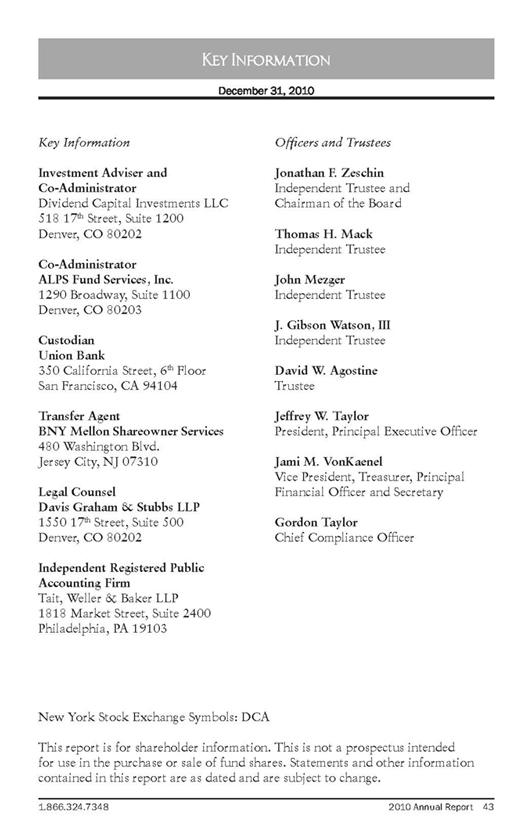
I Key Information I
Key Information
Investment Adviser and
Co-Administrator
Dividend Capital Investments LLC
518 17th Street, Suite 1200
Denver, CO 80202
Co-Administrator ALPS Fund Services, Inc. 1290 Broadway, Suite 1100 Denver, CO 80203
Custodian Union Bank
350 California Street, 6th Floor San Francisco, CA 94104
Transfer Agent
BNY Mellon Shareowner Services
480 Washington Blvd.
Jersey City, NJ 07310
Legal Counsel
Davis Graham & Stubbs LLP
1550 17th Street, Suite 500 Denver, CO 80202
Independent Registered Public Accounting Firm Tait, Weller & Baker LLP 1818 Market Street, Suite 2400 Philadelphia, PA 19103
Offficers and Trustees
Jonathan F. Zeschin
Independent Trustee and Chairman of the Board
Thomas H. Mack Independent Trustee
John Mezger Independent Trustee
J. Gibson Watson, II
Independent Trustee
David W. Agostine
Trustee
Jeffrey W. Taylor
President, Principal Executive Offficer
Jami M. VonKaenel
Vice President, Treasurer, Principal Financial Offficer and Secretary
Gordon Taylor
Chief Compliance Offficer
New York Stock Exchange Symbols: DCA
This report is for shareholder information. This is not a prospectus intended for use in the purchase or sale of fund shares. Statements and other information contained in this report are as dated and are subject to change.
1.866.324.7348 2010 Annual Report 43
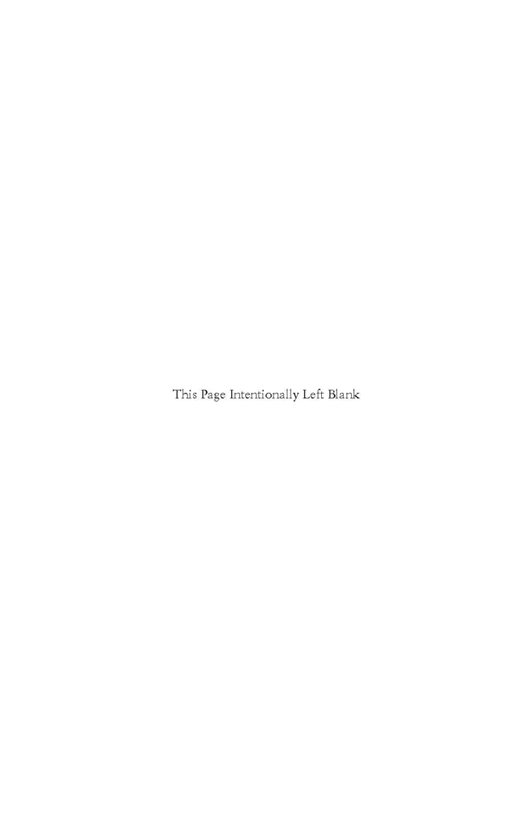
This Page Intentionally Left Blank
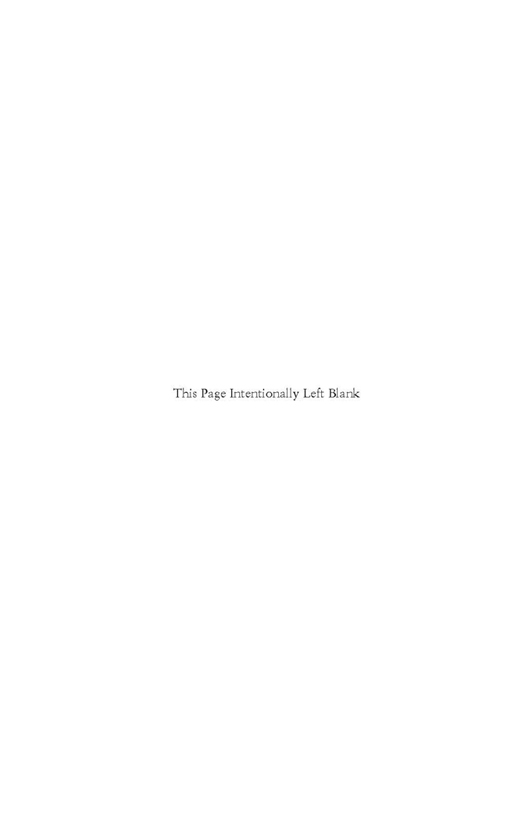
This Page Intentionally Left Blank
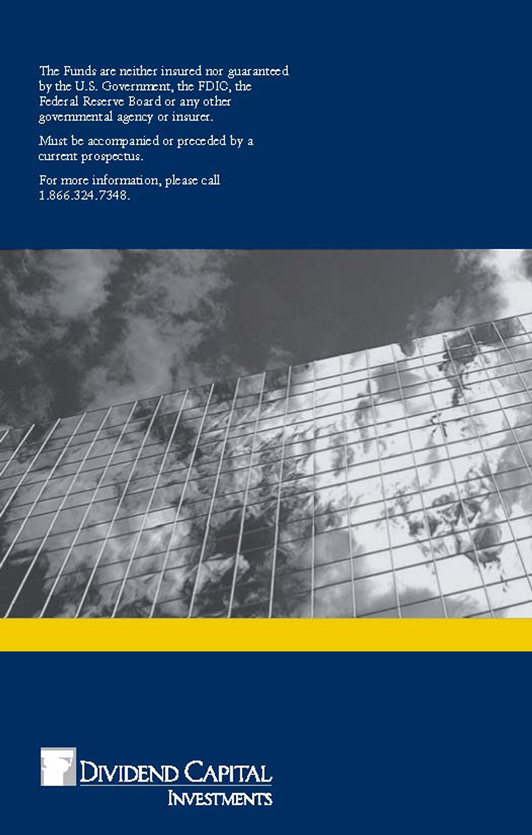
The Funds are neither insured nor guaranteed by the U.S. Government, the FDIC, the Federal Reserve Board or any other governmental agency or insurer.
Must be accompanied or preceded by a current prospectus.
For more information, please call 1.866.324.7348.
Item 2. Code of Ethics
| | (a) | The Registrant, as of the end of the period covered by the report, has adopted a code of ethics that applies to the Registrant’s principal executive officer, principal financial officer, principal accounting officer or controller or any persons performing similar functions on behalf of the Registrant. |
| | (c) | During the period covered by this report, no amendments were made to the provisions of the code of ethics adopted in 2(a) above. |
| | (d) | During the period covered by this report, no implicit or explicit waivers to the provisions of the code of ethics adopted in 2(a) were granted. |
| | (f) | The Registrant’s Code of Ethics is attached as an Exhibit hereto. |
Item 3. Audit Committee Financial Expert
The Registrant’s Board of Trustees has determined that Jonathan F. Zeschin and Thomas H. Mack each possesses the technical attributes identified in Instruction 2(b) of Item 3 to Form N-CSR to qualify as an “audit committee financial expert,” and has designated Messrs. Zeschin and Mack as the Audit Committee’s financial experts. Messrs. Zeschin and Mack are “independent” Trustees, as defined in paragraph (a)(2) of Item 3. Under applicable securities laws, a person who is determined to be an audit committee financial expert will not be deemed an “expert” for any purpose, including without limitation for the purposes of Section 11 of the Securities Act of 1933, as a result of being designated or identified as an audit committee financial expert. The designation or identification of a person as an audit committee financial expert does not impose on such person any duties, obligations, or liabilities that are greater than the duties, obligations, and liabilities imposed on such person as a member of the audit committee and Board of Trustees in the absence of such designation or identification.
Item 4. Principal Accountant Fees and Services
(a) – (d) Aggregate fees billed to the Registrant for the fiscal year ended December 31, 2010 for professional services rendered by the Registrant’s principal accountant were as follows:
| | | | | | | | |
| | | Fiscal Year Ended
December 31, 2009 | | | Fiscal Year Ended
December 31, 2010 | |
Audit Fees | | $ | 25,000 | | | $ | 26,000 | |
Audit-Related Fees | | | — | | | | — | |
Tax Fees | | $ | 5,000 | | | $ | 5,200 | |
All Other Fees | | | — | | | $ | 1,500 | |
The Audit Fees listed above reflect fees for the audit of the Registrant’s annual financial statements, or services that are normally provided by the Registrant’s auditor in connection with statutory and regulatory filings for the reporting periods.
The Tax Fees paid by the Registrant are for Tax Services including the review of the Fund’s federal and state income tax returns.
The All Other Fees paid in the Fiscal Year Ended December 31, 2010 are for fees in connection with the reorganization of the DCW Total Return Fund into the Fund.
Aggregate fees billed by the Registrant’s principal accountant for the fiscal year ended December 31, 2010 for non-audit services provided to the Registrant’s investment adviser and any entity controlling, controlled by, or under common control with Dividend Capital Investments LLC (the “Adviser”) that provides ongoing services to the registered investment company, where the engagement relates directly to the operations and financial reporting of the registrant, were as follows:
| | | | | | | | |
| | | Fiscal Year Ended
December 31, 2009 | | | Fiscal Year Ended
December 31, 2010 | |
Audit-Related Fees | | | — | | | | — | |
Tax Fees | | | — | | | | — | |
All Other Fees | | | — | | | | — | |
| (e)(1) | The Audit Committee pre-approves audit and non-audit services performed for the Registrant by the principal accountant. The Audit Committee also pre-approves non-audit services performed by the Registrant’s principal accountant for the Registrant’s Adviser and affiliates servicing the Registrant, if the engagement relates directly to the operations and financial reporting of the Registrant. |
The Audit Committee may delegate pre-approval authority to a subcommittee of one or more of its members. Any decision of the subcommittee to grant pre-approvals is presented to the full Audit Committee at its next regularly scheduled meeting.
| (e)(2) | No services described in paragraphs (b) through (d) above were approved pursuant to paragraph (c)(7)(i)(C) of Rule 2-01 of Regulation S-X. |
| (g) | Aggregate Non-Audit Fees: The aggregate non-audit fees billed by the Registrant’s accountant for services rendered to the Registrant, the Registrant’s Adviser and any entity controlling, controlled by, or under common control with the Adviser that provides ongoing services to the Registrant were $6,700 and $5,000 for the fiscal years ended December 31, 2010 and December 31, 2009, respectively. |
Item 5. Audit Committee of Listed Registrants
| | (a) | The Registrant has a separately-designated standing Audit Committee established in accordance with Section 3(a)(58)(A) of the Exchange Act. The committee members are: Jonathan F. Zeschin, Thomas H. Mack, John Mezger and J. Gibson Watson III. |
Item 6. Schedule of Investments
Included as part of the report to shareholders filed under Item 1 of this Form N-CSR.
Item 7. Disclosure of Proxy Voting Policies and Procedures for Closed-End Management Investment Companies
The Registrant has delegated, subject to the supervision of the Board, the voting of proxies relating to its voting securities to the Adviser and Sub-Adviser, each with respect to the portion of the Fund’s assets under its management. The Proxy and Corporate Action Voting Policies and Procedures of the Adviser and Sub-Adviser are attached as Exhibit 99.PROXYPOL hereto.
Item 8. Portfolio Managers of Closed-End Management Investment Companies.
| (a)(1) | Adviser’s Portfolio Management Team |
The Adviser’s investment committee (“Investment Committee”) is charged with the overall management of the Registrant’s portfolio, including the development and implementation of overall portfolio strategy and the day-to-day management of the portfolio. The Investment Committee is composed of Mr. Jeffrey Taylor, President and Chief Operating Officer of the Adviser.
Biographical Information
Biographical information regarding the Adviser’s Investment Committee Member is set forth below:
Jeffrey Taylor, CFA. Mr. Taylor is the President and Chief Operating Officer of the Adviser. In addition to his position with the Adviser, Mr. Taylor is also the Senior Vice President of Operations for Black Creek Group LLC. Prior to joining the Adviser in 2004, he served in various positions with INVESCO Funds Group, most notably as product manager and manager of marketing and business analytics, where he was responsible for the development of the company’s portfolio review and product rationalization processes, as well as strategic business analysis and planning initiatives. Mr. Taylor holds a bachelor’s degree from Pennsylvania State University and an MBA from the University of Colorado at Denver.
Sub-Adviser’s Portfolio Management Team
Calamos Advisors LLC (“Calamos”) employs a team approach to portfolio management, led by the Co-Chief Investment Officers (“Co-CIOs”) and comprised generally of the Co-CIOs, Co-Heads of Research and Investments, senior strategy analysts, intermediate analysts and junior analysts. The Co-CIOs, Co-Heads of Research and Investments and senior strategy analysts are supported by and lead a team of investment professionals whose valuable contributions create a synergy of expertise that can be applied across many different investment strategies.
Portfolio holdings are reviewed and trading activity is discussed on a regular basis by team members. Team members, including the Co-CIOs, Co-Heads of Research and Investments, and senior strategy analysts, may each make trading decisions guided by the Fund’s investment objective and strategy.
While day-to-day management of the Fund is a team effort, the Co-CIOs, along with the Co-Heads of Research and Investments and senior strategy analysts, have joint primary and supervisory responsibility for the Fund and work with all team members in developing and executing the Fund’s investment program. Each is further identified below.
Biographical Information
Biographical information regarding the Sub-Adviser’s portfolio management team is set forth below:
John P. Calamos, Sr. and Nick P. Calamos, Co-CIOs of Calamos, generally focus on firmwide risk management and the top-down approach of diversification by country and industry sector and macro-level investment themes.
Nick P. Calamos, Co-CIO and President of Investments of Calamos, also focuses on portfolio level risk management, sector and country weightings, bottom-up fundamental security analysis, and corresponding research and analysis for key holdings. As Co-CIOs, Messrs, John P. Calamos, Sr. and Nick P. Calamos direct the team’s focus on macro themes, upon which the portfolio’s strategy is based. The team, as a whole, implements the investment strategies, under the general direction and supervision of the Co-CIOs, as well as the Co-Heads of Research and Investments, Jeff Scudieri and Jon Vacko, and the senior strategy analysts. Nick Calamos, along with Jeff Scudieri and Jon Vacko are responsible for the day-to-day management of the team, bottom-up research efforts and strategy implementation. John Calamos, Jr., John Hillenbrand, Steve Klouda, Christopher Hartman and Joe Wysocki are each senior strategy analysts.
During the past five years, John P. Calamos, Sr. has been President and Trustee of the Calamos Investment Trust and chairman, CEO and Co-CIO of Calamos and its predecessor company, and Nick P. Calamos has been Vice President and Trustee of the Calamos Investment Trust (through June 2006) and President of Investments and Co-CIO of Calamos and its predecessor company. Jeff Scudieri joined Calamos in 1997 and has been Senior Vice President, Co-Head of Research and Investments since July 2007, prior thereto he was a senior strategy analyst. Jon Vacko joined Calamos in 2000 and has been a Senior Vice President, Co-Head of Research and Investments since July 2007, prior thereto he was a senior strategy analyst since July 2002. John P. Calamos, Jr., Executive Vice President of Calamos, joined the firm in 1985 and has held various senior investment positions since that time. John Hillenbrand joined Calamos in 2002 and has been a senior strategy analyst since August 2002. Steve Klouda joined Calamos in 1994 and has been a senior strategy analyst since July 2002. Christopher Hartman joined Calamos in February 1997 and has been a senior strategy analyst since May 2007. Joe Wysocki joined Calamos in October 2003 and has been a senior strategy analyst since February 2007.
| (a)(2) | The following table provides information about the other registered investment companies, other pooled investment vehicles and other accounts managed by the Adviser’s Investment Committee Member who is primarily responsible for the day-to-day management of any other portfolio as of December 31, 2010: |
| | | | | | | | | | |
| | | | | Number of All Other
Accounts | | | Total Assets of All
Other Accounts
(in millions) | |
Mr. Jeffrey Taylor: | | Other Registered Investment Companies | | | 0 | | | $ | — | |
| | Other Pooled Investment Vehicles | | | 0 | | | $ | — | |
| | Other Accounts | | | 1 | | | $ | 0.80 | |
None of the accounts listed above have all or a portion of their advisory fee based on performance of the account.
The Sub-Adviser’s Portfolio Management team also has responsibility for the day-to-day management of accounts other than the Fund. Information regarding these other accounts as of December 31, 2010 is set forth below:
| | | | | | | | | | |
| | | | | Number of All Other
Accounts | | | Total Assets of All
Other Accounts
(in millions) | |
| Mr. John P. Calamos, Sr.: | | Registered Investment Companies | | | 25 | | | $ | 27,202 | |
| | Other Pooled Investment Vehicles | | | 11 | | | $ | 1,291 | |
| | Other Accounts | | | 7,655 | | | $ | 6,920 | |
| Mr. Nick P. Calamos: | | Registered Investment Companies | | | 25 | | | $ | 27,202 | |
| | Other Pooled Investment Vehicles | | | 11 | | | $ | 1,291 | |
| | Other Accounts | | | 7,655 | | | $ | 6,920 | |
| Mr. John P. Calamos, Jr.: | | Registered Investment Companies | | | 25 | | | $ | 27,202 | |
| | Other Pooled Investment Vehicles | | | 11 | | | $ | 1,291 | |
| | Other Accounts | | | 7,655 | | | $ | 6,920 | |
| Mr. Jeff Scudieri: | | Registered Investment Companies | | | 25 | | | $ | 27,202 | |
| | Other Pooled Investment Vehicles | | | 11 | | | $ | 1,291 | |
| | Other Accounts | | | 7,655 | | | $ | 6,920 | |
| Mr. Jon Vacko: | | Registered Investment Companies | | | 25 | | | $ | 27,202 | |
| | Other Pooled Investment Vehicles | | | 11 | | | $ | 1,291 | |
| | Other Accounts | | | 7,655 | | | $ | 6,920 | |
| Mr. John Hillenbrand: | | Registered Investment Companies | | | 25 | | | $ | 27,202 | |
| | Other Pooled Investment Vehicles | | | 11 | | | $ | 1,291 | |
| | Other Accounts | | | 7,655 | | | $ | 6,920 | |
| Mr. Steve Klouda: | | Registered Investment Companies | | | 25 | | | $ | 27,202 | |
| | Other Pooled Investment Vehicles | | | 11 | | | $ | 1,291 | |
| | Other Accounts | | | 7,655 | | | $ | 6,920 | |
| Mr. Christopher Hartman: | | Registered Investment Companies | | | 25 | | | $ | 27,202 | |
| | Other Pooled Investment Vehicles | | | 11 | | | $ | 1,291 | |
| | Other Accounts | | | 7,655 | | | $ | 6,920 | |
| Mr. Joe Wysocki: | | Registered Investment Companies | | | 25 | | | $ | 27,202 | |
| | Other Pooled Investment Vehicles | | | 11 | | | $ | 1,291 | |
| | Other Accounts | | | 7,655 | | | $ | 6,920 | |
The number of accounts and assets for which the advisory fee is performance based as of December 31, 2010 are set forth below:
| | | | | | | | | | |
| | | | | Accounts | | | Assets
(in Millions) | |
Mr. John P. Calamos Sr. | | Registered Investment Companies | | | 3 | | | $ | 426 | |
| | Other Pooled Investment Vehicles | | | 1 | | | $ | 20 | |
| | Other Accounts | | | 0 | | | $ | — | |
Mr. Nick P. Calamos | | Registered Investment Companies | | | 3 | | | $ | 426 | |
| | Other Pooled Investment Vehicles | | | 1 | | | $ | 20 | |
| | Other Accounts | | | 0 | | | $ | — | |
Mr. John P. Calamos, Jr. | | Registered Investment Companies | | | 3 | | | $ | 426 | |
| | Other Pooled Investment Vehicles | | | 1 | | | $ | 20 | |
| | Other Accounts | | | 0 | | | $ | — | |
Mr. Jeff Scudieri | | Registered Investment Companies | | | 3 | | | $ | 426 | |
| | Other Pooled Investment Vehicles | | | 1 | | | $ | 20 | |
| | Other Accounts | | | 0 | | | $ | — | |
Mr. Jon Vacko | | Registered Investment Companies | | | 3 | | | $ | 426 | |
| | Other Pooled Investment Vehicles | | | 1 | | | $ | 20 | |
| | Other Accounts | | | 0 | | | $ | — | |
Mr. John Hillenbrand | | Registered Investment Companies | | | 3 | | | $ | 426 | |
| | Other Pooled Investment Vehicles | | | 1 | | | $ | 20 | |
| | Other Accounts | | | 0 | | | $ | — | |
Mr. Steve Klouda | | Registered Investment Companies | | | 3 | | | $ | 426 | |
| | Other Pooled Investment Vehicles | | | 1 | | | $ | 20 | |
| | Other Accounts | | | 0 | | | $ | — | |
Mr. Christopher Hartman | | Registered Investment Companies | | | 3 | | | $ | 426 | |
| | Other Pooled Investment Vehicles | | | 1 | | | $ | 20 | |
| | Other Accounts | | | 0 | | | $ | — | |
Mr. Joe Wysocki | | Registered Investment Companies | | | 3 | | | $ | 426 | |
| | Other Pooled Investment Vehicles | | | 1 | | | $ | 20 | |
| | Other Accounts | | | 0 | | | $ | — | |
Conflicts of Interest
From time to time, potential conflicts of interest may arise between the Investment Committee Member’s management of the investments of the Registrant, on the one hand, and the management of other accounts, on the other. The other accounts might have similar investment objectives or strategies as the Registrant, track the same index the Registrant tracks or otherwise hold, purchase, or sell securities that are eligible to be held, purchased or sold by the Registrant. The other accounts might also have different investment objectives or strategies than the Registrant.
| | • | | Knowledge and Timing of Registrant Trades. A potential conflict of interest may arise as a result of the Investment Committee Member’s management of the Registrant’s portfolio. Because of his position with the Adviser and the Registrant, the Investment Committee Member knows the size, timing and possible market impact of the Registrant’s trades. It is theoretically possible that the Investment Committee Member could use this information to the advantage of other accounts managed and to the possible detriment of the Registrant. |
| | • | | Investment Opportunities. A potential conflict of interest may arise as result of the Investment Committee Member’s management of a number of accounts with varying investment guidelines. Often, an investment opportunity may be suitable for both the Registrant and other accounts managed by the Investment Committee Member, but may not be available in sufficient quantities for both the Registrant and the other accounts to participate fully. Similarly, there may be limited opportunity to sell an investment held by the Registrant and another account. The Adviser has adopted policies and procedures reasonably designed to allocate investment opportunities on a fair and equitable basis over time. |
Under the Adviser’s allocation procedures, investment opportunities are allocated among various investment strategies based on individual account investment guidelines and the Adviser’s investment outlook. The Adviser has also adopted additional procedures to complement the general trade allocation policy that are designed to address potential conflicts of interest due to the side-by-side management of the Registrant and certain other accounts, including investment opportunity allocation issues.
(a)(3) Adviser’s Portfolio Management Team Compensation
The objective of the Adviser’s portfolio compensation program is to provide pay and long-term compensation for its employees that is competitive with the real estate management, and mutual fund/investment advisory market relative to the Adviser’s size and geographical location. Investment Committee Members participate in a compensation program that includes base salary, the potential for a discretionary bonus and the potential for long-term incentives. Investment Committee Member compensation is reviewed and may be modified each year as appropriate to reflect changes in the market, as well as to adjust the factors used to determine bonuses to promote good sustained investment performance.
| | • | | Base Salary. Each Investment Committee Member is paid a base salary by the Adviser or one of its related companies. In setting the base salary, the Adviser’s intention is to be competitive in light of the Investment Committee Member’s experience and responsibilities. The base salary is also a function of industry salary rates and individual performance as measured against annual goals. |
| | • | | Annual Bonus. Each Investment Committee Member is eligible to receive from the Adviser or one of its related companies an annual cash bonus that may be equal to as much as 200% of his annual base salary. This bonus is determined by the Investment Committee Member’s contribution to investment management results consistent with the Registrant’s stated objectives as well as other qualitative and quantitative factors taken into consideration. |
| | • | | Long-Term Incentive Program. Each Investment Committee Member has the potential to participate in a long-term incentive program which may include an equity ownership program in the Adviser or one of its related companies. Equity ownership is awarded based on individual contributions to the Adviser’s business and the long-term potential of that individual to the Adviser. |
Sub-Adviser’s Portfolio Management Team Compensation
As of October 31, 2010, Team Leaders John P. Calamos, Sr., Nick P. Calamos and John P. Calamos, Jr. receive all of their compensation from Calamos. Each has entered into an employment agreement that provides for compensation in the form of an annual base salary and a target bonus, both components payable in cash. Their target bonus is set at a percentage of the respective base salary, ranging from 300% to 600%, with a maximum annual bonus opportunity of 150% of the target bonus. For example, the target bonus for a Team Leader who earns $500,000 would range from $1,500,000 to $3,000,000 and the Team Leader’s maximum annual bonus opportunity would range from $2,250,000 to $4,500,000. Also, due to the ownership and executive management positions with Calamos Asset Management, Inc., additional multiple corporate objectives are utilized to determine the target bonus for John P. Calamos, Sr., Nick P. Calamos and John P. Calamos, Jr. For 2010, the additional corporate objectives were distribution effectiveness, as measured by redemption rates and sales growth; investment performance, as measured by risk-adjusted performance of the investment strategies managed by Calamos over a blended short- and long-term measurement period; income growth, as measured by operating margin and return on invested capital and the corporate investment portfolio; management evaluation, based upon several factors including the execution of strategic initiatives; and stockholder return relative to the industry peer group.
As of October 31, 2010, Team Leaders Jeff Scudieri, Jon Vacko, John Hillenbrand, Steve Klouda, Chris Hartman and Joe Wysocki receive all of their compensation from Calamos. They each receive compensation in the form of an annual base salary, a discretionary bonus (payable in cash) and long-term incentive awards. Each of these associates has a bonus range opportunity which is expressed as a percentage of base salary. Each of these associates is also eligible for discretionary long-term incentive awards, however these awards are not guaranteed from year to year. Long-term incentive awards consist of restricted stock units or a combination of restricted stock units and stock options.
The amounts paid to all Team Leaders and the criteria utilized to determine the amounts are benchmarked against industry specific data provided by third party analytical agencies. The Team Leaders’ compensation structure does not differentiate between the Fund and other accounts managed by the Team Leaders, and is determined on an overall basis, taking into consideration the performance of the various strategies managed by the Team Leaders. Portfolio performance, as measured by risk-adjusted portfolio performance, is utilized to determine the target bonus, as well as overall performance of Calamos.
All Team Leaders are eligible to receive annual equity awards in shares of Calamos Asset Management, Inc. under an incentive compensation plan. The target annual equity awards are set at a percentage of their respective base salaries.
Historically, the annual equity awards granted under the incentive compensation plan have been comprised of stock options and restricted stock units. Most of the stock options and restricted stock units issued have vested annually in one-third installments beginning in the fourth year after the grant date and each award has been subject to accelerated vesting under certain conditions. Unless terminated early, the stock options have a ten-year term.
| (a)(4) | The following table shows the dollar range of shares of the Registrant owned by the Investment Committee Member as of December 31, 2010. |
| | | | | | | | | | |
Name | | $0 | | | $1-$10,000 | | | $10,001-$50,000 |
Mr. Taylor | | | | | | | | | | X |
Item 9. Purchases of Equity Securities by Closed-End Management Investment Company and Affiliated Purchasers.
Not applicable.
Item 10. Submission of Matters to Vote of Security Holders
There were no material changes to the procedures by which shareholders may recommend nominees to the Registrant’s Board of Trustees that were implemented after the Registrant last provided disclosure in response to the requirements of Item 407(c)(2)(iv) of Regulation S-K (17 CFR 229.407) (as required by 22(b)(15)) of Schedule 14A (17 CFR 240.14a-101), or this Item 10.
Item 11 – Controls and Procedures
| (a) | Based on an evaluation of the disclosure controls and procedures (as defined in Rule 30a-3(c) under the Act) as of a date within 90 days of the filing date of this report, the Chief Executive Officer and Principal Financial Officer of the Registrant have each concluded that such disclosure controls and procedures provide reasonable assurance that information required to be disclosed by the Registrant is accumulated and communicated to the Registrant’s management to allow timely decisions regarding required disclosure. |
| (b) | There were no changes in the Registrant’s internal controls over financial reporting (as defined in Rule 30a-3(d) under the Act) that occurred during the second fiscal quarter of the period covered by this report that have materially affected, or are reasonably likely to materially affect, the Registrant’s internal control over financial reporting. |
Item 12 – Exhibits
| | |
| |
| (a)(1)(i) | | The code of ethics that applies to the Registrant’s principal executive officer and principal financial officer is attached hereto as Exhibit 12.A.1. |
| |
| (a)(1)(ii) | | The Proxy and Corporate Action Voting Policies and Procedures of the Adviser and Sub-Adviser are attached hereto as Exhibit 99.PROXYPOL |
| |
| (a)(2) | | The certifications required by Rule 30a-2(a) of the Act (17 CFR 270.30a-2(a)) are filed and attached hereto as Exhibit 99.CERT. |
| |
| (a)(3) | | Not applicable to the Registrant. |
| |
| (b) | | The certification required by Rule 30a-2(b) of the Act (17 CFR 270.30a-2(b)) is filed and attached hereto as Exhibit 99.906CERT. |
SIGNATURES
Pursuant to the requirements of the Securities Exchange Act of 1934 and the Investment Company Act of 1940, the Registrant has duly caused this report to be signed on its behalf by the undersigned, thereunto duly authorized.
| | |
| DCA Total Return Fund |
| |
| By: | | /s/ Jeffrey W. Taylor |
| | Jeffrey W. Taylor |
| | President (Principal Executive Officer) |
| |
| Date: | | March 10, 2011 |
Pursuant to the requirements of the Securities Exchange Act of 1934 and the Investment Company Act of 1940, this report has been signed below by the following persons on behalf of the Registrant and in the capacities and on the dates indicated.
| | |
| By: | | /s/ Jeffrey W. Taylor |
| | Jeffrey W. Taylor |
| | President (Principal Executive Officer) |
| |
| Date: | | March 10, 2011 |
| | |
| By: | | /s/ Jami M. VonKaenel |
| | Jami M. VonKaenel |
| | Treasurer (Principal Financial Officer) |
| |
| Date: | | March 10, 2011 |














































